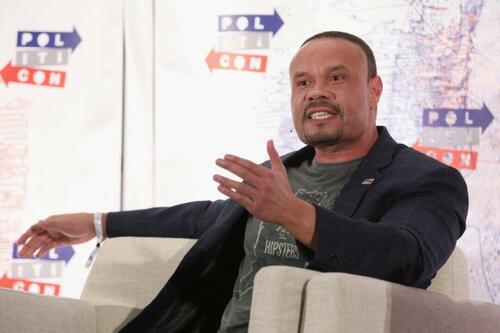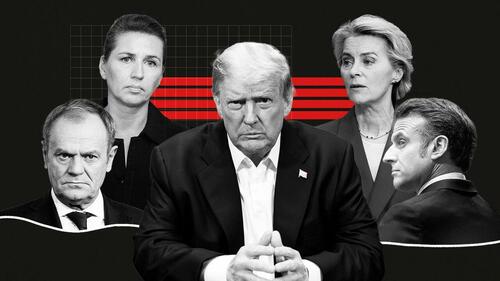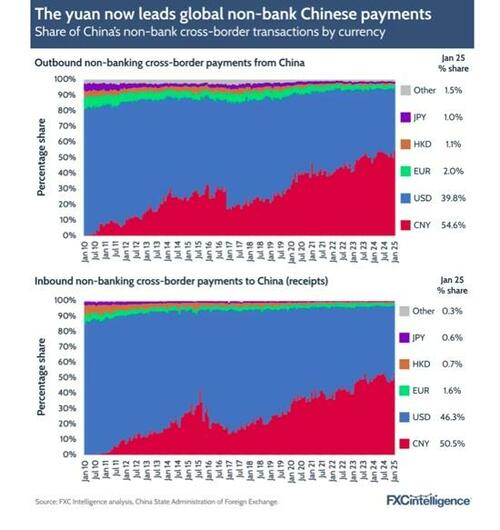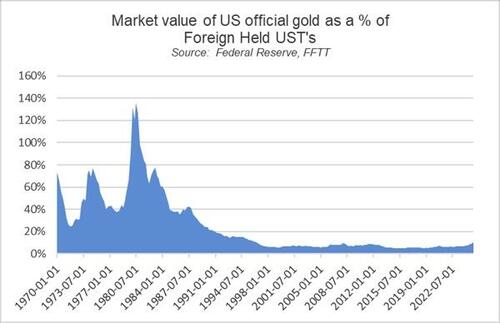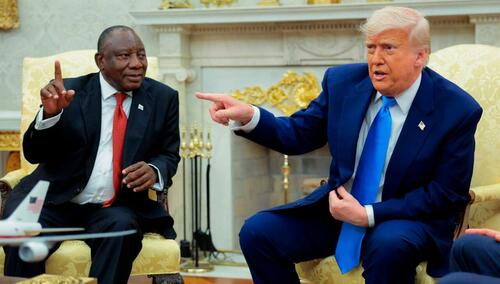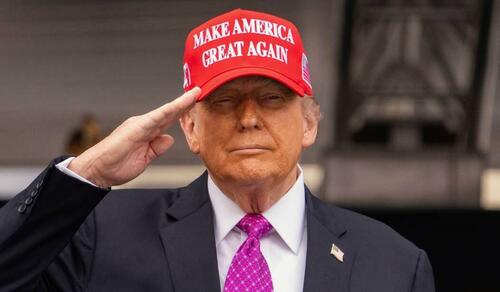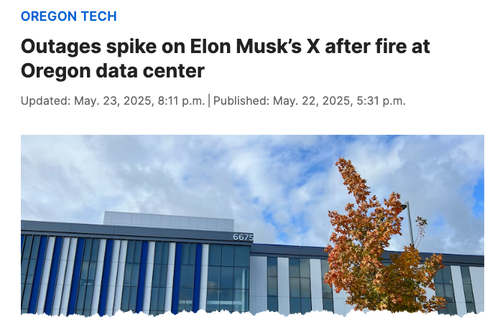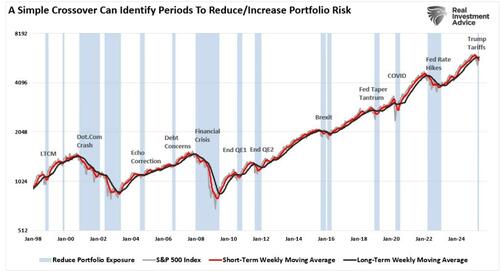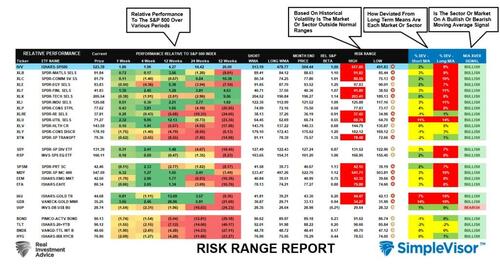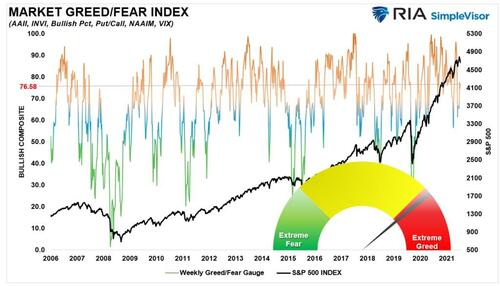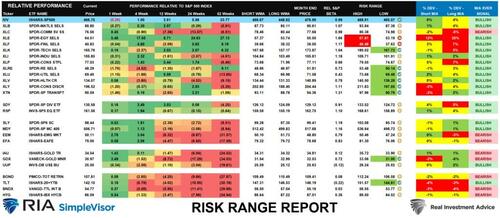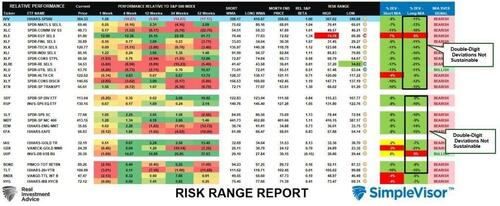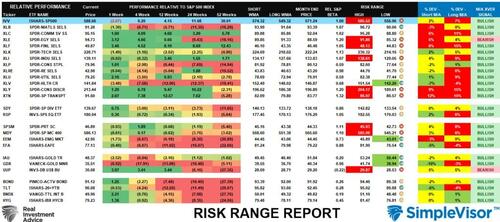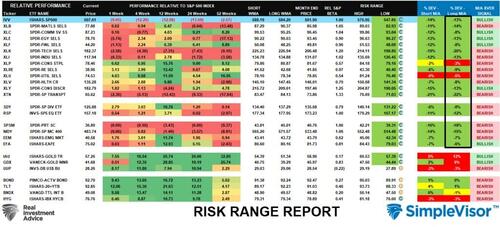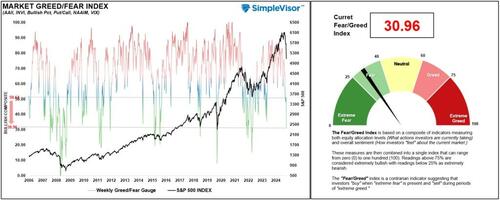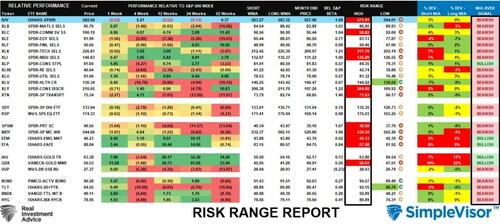In the name of tolerance, tolerance is being abolished; this is a real threat we face.
Distinction Matter - Subscribed Feeds
-
Site: Mises InstituteWe know what happened on November 22, 1963, at Dealey Plaza in Dallas, but there is a lot about that terrible day we don't know.
-
Site: Mises InstituteWe know what happened on November 22, 1963, at Dealey Plaza in Dallas, but there is a lot about that terrible day we don't know. But we also know that President Kennedy challenged the National Security State. Did it cost him his life?
-
Site: Zero HedgeFBI Deputy Director Bongino Says Bureau Looking At Several Cases Involving 'Potential Public Corruption'Tyler Durden Tue, 05/27/2025 - 06:30
Authored by Jack Phillips via The Epoch Times,
FBI Deputy Director Dan Bongino said on May 26 that the bureau is looking at launching investigations into cases of potential public corruption.
“Shortly after swearing in, [FBI Director Kash Patel] and I evaluated a number of cases of potential public corruption that, understandably, have garnered public interest,” Dan Bongino wrote in a post on social media platform X on the morning of May 26.
Bongino, a former Secret Service agent and radio host, noted that they “made the decision to either re-open, or push additional resources and investigative attention, to these cases.”
One case that they are looking to target is the FBI investigation into the alleged pipe bombs left near the Democratic and Republican national committee buildings in Washington a day before the Jan. 6, 2021, Capitol breach, he said.
The FBI said in 2024 that a $500,000 reward is still in effect for information leading to the arrest of the pipe bomb suspect. Earlier in 2025, David Sundberg, former assistant director in charge of the FBI Washington Field Office, told CNN that officials are seeking new leads.
“Maybe allegiances have changed or relationships have changed, and it’s time to report [on the suspect],” Sundberg told the outlet.
“Tips from the public really have been very helpful but, as I mentioned, we’re still trying to identify the suspect. So we’re trying to release a little more information such that maybe it will jog somebody’s memory.”
Other cases that warrant more resources include one involving the discovery of cocaine in the White House in July 2023 and the leak of the Supreme Court’s decision that overturned Roe v. Wade in June 2022, Bongino said.
“I receive requested briefings on these cases weekly and we are making progress,” he said in his post.
“If you have any investigative tips on these matters that may assist us then please contact the FBI.”
Also in his X post, Bongino said he and Patel have conducted one media interview together, which was with Fox News in May.
“We decided early on to limit our media footprint overall in order to keep the attention on the work being done,” he said.
“We have chosen to communicate, in writing, on this platform to fill some of the inevitable information vacuums.
“I try to read as much of your feedback as possible but the workday is busy, and my office is a [sensitive compartmented information facility] with limited phone access. In response to feedback, both positive and negative, from our interview last week we will be releasing more information which will further clarify answers to some of the questions asked in the interview.”
In the Fox News interview, Patel and Bongino were asked about the death of convicted sex trafficker and financier Jeffrey Epstein in August 2019. They said his cause of death was suicide, which medical examiners determined after his body was found hanged in a New York City jail.
“They have their right to their opinion but as someone who has worked as a public defender, as a prosecutor who’s been in that prison system, who’s been in the Metropolitan Detention Center, who’s been in segregated housing, you know a suicide when you see one, and that’s what that was,” Patel told Fox News.
Bongino said he agreed with Patel’s assessment that Epstein’s death was by suicide.
“He killed himself. ... I have seen the whole file,” Bongino said during the interview.
Since Epstein’s body was found, there has been widespread speculation that he did not kill himself. His brother, Mark Epstein, told news outlets in 2019 that he believes that his brother did not die by suicide, and he reiterated those claims during an interview with Megyn Kelly in 2024.
Meanwhile, Patel confirmed on May 18 that the FBI is investigating New York Attorney General Letitia James over her real estate transactions.
-
Site: AsiaNews.itIn the race with Washington for dominance in this crucial sector, Beijing has now introduced new educational guidelines aimed at equipping students with the ability to design algorithms by the time they reach secondary school. Rather than solely focusing on developing the most advanced technologies, China aims to win this global competition by cultivating a society that can fully harness the potential of these tools.
-
Site: AsiaNews.itToday's news : Dozens more killed in Israeli air raids on Gaza as settlers march through central Jerusalem to mark the anniversary of its 'unification';Record turnout among overseas voters in South Korea's presidential elections;A weak yen causes Japan to lose its status as the world's largest creditor nation;In Bishkek, Kyrgyzstan's first centre to support mothers and children opens.
-
Site: Zero HedgeMerz Says Western Alliance Has Lifted 'Absolutely' All Range Limits For Arms Sent To UkraineTyler Durden Tue, 05/27/2025 - 05:45
On this extended Memorial Day weekend where many Americans will be spending time with family around the grill, and perhaps at local parades and remembrance events, the showdown between NATO and Russia in Ukraine just escalated in a big way.
German Chancellor Friedrich Merz has announced Monday that Germany, France, the UK and US have lifted prior restrictions on how far the weapons they supply to Ukraine can reach. "Absolutely no limits...," he said.
 Keir Starmer, Friedrich Merz and Emmanuel Macron. via dpa
Keir Starmer, Friedrich Merz and Emmanuel Macron. via dpa
"There are absolutely no range limits anymore for weapons delivered to Ukraine, not from Britain, the French or from us — also not from the Americans," Merz said speaking at a national security forum in Berlin on Monday. "That means Ukraine can defend itself by attacking military positions also in Russia."
Russian media very quickly seized on the comments as representing a major turning point in NATO policy vis-a-vis Ukraine. Bloomberg too has emphasized this gives Ukraine the "greenlight" to strike deep inside Russia.
Of course, any close observer of the war over much of the last year knows that the proverbial gloves have already been off for a long time, on a covert level at least. Ukrainian drones have been reaching far into Russian territory for years for many many months at this point, with US satellite and intelligence assistance.
Chancellor Merz made clear in the Monday remarks:
"There are no longer any range restrictions on weapons supplied to Ukraine, not from the British, not from the French, not from us, not from the Americans either. This means that Ukraine can now also defend itself by attacking military positions in Russia, for example. It couldn't do that until some time ago, and with very few exceptions, it didn't do that until some time ago."
He claimed further, "Now it can. In jargon, we call this long-range fire, i.e., equipping Ukraine with weapons that attack military targets in the rear. And that is the decisive qualitative difference in Ukraine's warfare. Russia attacks civilian targets absolutely ruthlessly, bombing cities, kindergartens, hospitals, and old people's homes." He added: "Ukraine does not do that."
"And we attach great importance to keeping it that way," Merz said. "But, a country that can only defend itself against an attacker on its own territory is not defending itself adequately. And this defense of Ukraine is now also taking place against military infrastructure on Russian territory."
But again, long-range fire utilizing Western systems has been in effect for a while at this point, and cities and residential homes and neighborhoods have indeed been hit, and Russian civilians have died - just as has been happening in Ukraine as a result of Russian attacks.
Whether Washington, London, and Paris have actually pulled the trigger on making this decision 'official' is another question. The White House certainly hasn't changed its public stance, and a moment President Trump has been piling on the pressure for each side to get to the negotiating table.
Europe's decision, if there is one, to lift the missile range restrictions on weapons supplied to Ukraine is dangerous and is contrary to aspirations of reaching a settlement, Peskov said.
— Anton Gerashchenko (@Gerashchenko_en) May 26, 2025
"The decisions, if indeed there are such decisions, are absolutely contrary to our… https://t.co/SpIOGoqlQ5 pic.twitter.com/L1qcicSxplThe Kremlin responded later Monday with its own warning, with spokesman Dimitry Peskov saying that "If such decisions have indeed been made, they are entirely at odds with our aspirations for a political resolution and with the efforts currently being made toward a settlement."
He then said ominously, "Quite dangerous decisions, again – if they were indeed made."
-
Site: AsiaNews.itZurab Dzhaparidze, one of the leaders of the 'Coalition for Change' opposing the Georgian Dream regime, has been arrested for refusing to pay a fine imposed on him for failing to appear before a parliamentary inquiry commission he considers 'illegitimate' due to electoral fraud. 'If people refused to live in lies, the regime would collapse instantly,' he declared.
-
Site: Real Investment Advice
As retirement approaches—or begins—investors often find themselves at a crossroads: How can you preserve the wealth you’ve accumulated while still ensuring it continues to grow? Striking the right balance between growth and safety in your retirement portfolio is one of the most important financial decisions you'll make.
The key is understanding the trade-offs and creating a retirement portfolio strategy that aligns with your long-term financial goals, income needs, and tolerance for risk.
The Growth vs. Safety Trade-Off
In retirement planning, growth refers to investments that have the potential for capital appreciation—such as stocks or equity mutual funds. These investments help your portfolio outpace inflation and support income needs over time.
Safety, on the other hand, focuses on preserving capital and minimizing risk. Conservative investments like bonds, money market funds, and annuities provide more stability, but typically offer lower returns.
The challenge is that favoring too much safety can leave your portfolio vulnerable to inflation and longevity risk (the risk of outliving your money), while leaning too heavily on growth can expose you to market volatility.
Why You Still Need Growth in Retirement
While your working years may be behind you, your portfolio still needs to work for you. Many retirees will spend 20–30 years or more in retirement, and during that time, your cost of living will likely rise.
Growth-oriented investments help combat inflation and ensure that your portfolio can support your lifestyle throughout retirement. Without a growth component, your nest egg may erode faster than expected.
The Role of Asset Allocation
Asset allocation is the foundation of a well-balanced retirement portfolio. It refers to how your investments are divided among asset classes—typically stocks, bonds, and cash equivalents.
A typical retirement portfolio might include:
- Equities for long-term growth
- Fixed income like bonds for income and stability
- Cash equivalents for liquidity and emergency needs
Adjusting this mix as you age or as your financial situation changes is key to maintaining the right balance. For example, a 65-year-old retiree may choose a 60/40 or 50/50 stock-to-bond allocation, depending on their goals and risk tolerance.
Conservative Investments for Stability
Retirement portfolios often include more conservative investments to reduce volatility. These include:
- Bonds: Offer regular interest payments and are generally less volatile than stocks. Bond laddering—buying bonds with staggered maturities—can help manage interest rate risk.
- Annuities: Provide guaranteed income for life or a set period. While they can lack flexibility, they can be a helpful tool for covering essential expenses.
- Dividend-paying stocks: These can offer a blend of income and potential growth, especially from companies with a history of consistent payouts.
Rebalancing and Adjusting Over Time
Markets change, and so should your portfolio. Regular rebalancing—adjusting your asset allocation to match your goals—helps you stay on track. For instance, if your stock allocation grows significantly during a bull market, it may expose you to more risk than intended.
Additionally, consider shifting to more conservative investments as you move deeper into retirement, especially if your spending increases or your health needs change.
Managing Risk Without Sacrificing Opportunity
Balancing growth and safety isn’t about avoiding risk altogether—it’s about managing it wisely. With the right strategy, you can:
- Generate income to cover your expenses
- Preserve capital to support your legacy goals
- Participate in market gains without excessive exposure
A financial advisor can help you evaluate your current strategy, clarify your retirement goals, and adjust your allocation as needed to reflect both current conditions and your future needs.
Ready to fine-tune your retirement portfolio strategy?
Contact RIA Advisors today to schedule a consultation. Our experienced fiduciary team will help you strike the right balance between growth and safety, so you can move forward with confidence.
FAQs
How much risk should I take with my retirement portfolio?
This depends on your age, financial goals, and risk tolerance. Most retirees benefit from a mix of growth and conservative investments.
Are bonds a safe choice during inflation?
Some bonds lose value during inflation, but short-term bonds or Treasury Inflation-Protected Securities (TIPS) can help preserve capital.
Do I still need stocks in retirement?
Yes. Equities help your portfolio grow over time and protect against inflation. They can be balanced with more stable investments.
What’s the benefit of using annuities?
Annuities can provide a guaranteed income stream, which can help cover essential expenses in retirement without relying on market returns.
How often should I rebalance my portfolio?
It’s smart to review your allocation at least annually or after major life events. A financial advisor can help monitor and adjust as needed.
The post How to Balance Growth and Safety in Your Retirement Portfolio appeared first on RIA.
-
Site: Crisis Magazine

Although our country has Protestant roots and is still predominantly Protestant, we are now accustomed to Catholics in high political office. Unfortunately, many of those Catholic politicians—people such as Joe Biden, Nancy Pelosi, and Richard Durbin—aren’t very good Catholics, showing disdain for fundamental Catholic teaching like the dignity of the unborn and the sacredness of marriage. Now…
-
Site: Real Investment Advice
After a bout of relative market tranquility, investors were rudely awakened Friday with a barrage of new tariff actions targeting the EU and Apple. Via Truth Social, Trump recommended a 50% tariff on European Union imports starting June 1, 2025, and a 25% tariff on all iPhones made outside the US.
Regarding the EU, the new 50% tariff replaces the 20% tariff on EU goods set in April. At that time, the EU proposed retaliatory tariffs. Therefore, the new tariff increases the odds of a deeper trade war with the EU nations. The EU as a whole is one of our top trade partners. In 2024, the US exported $370 billion of goods to the EU, while we imported $605 billion, resulting in a US goods trade deficit with the EU of $235 billion. Conversely, we have a trade surplus of $109 billion with the EU in the service sector.
Trump also proposed a 25% tariff on all iPhones manufactured outside the country. If you recall, Apple's CEO, Tim Cook, negotiated with Trump and secured exemptions from steep Chinese import tariffs in April 2025. The new proposed tariffs could significantly increase iPhone prices if implemented and fully passed through to consumers.

What To Watch Today
Earnings
- No notable earnings reports
Economy

Market Trading Update
Last week, we discussed how the rally had repaired much of the previous damage following the correction. As we noted:
"This past week, the market continued its advance. There is little reason to be bearish with key overhead resistance levels broken. However, as shown, the markets are reaching decently overbought levels after being extremely oversold. This suggests that at least for now, the "easy money" has been made. With the market above the 200, and above the 50 and 20-DMA, pullbacks should be between 5600 and 5800. Investors can use such a pullback to increase portfolio equity exposures and reduce hedges accordingly. Conversely, 5000 to 5200 becomes the next critical target if those lower supports are violated. Notably, such would require some unexpected event to unfold."
Several times this past week, we discussed that the market was due for a corrective pullback after reaching more overbought conditions. On Friday, the market gave way early in the morning on fresh comments by President Trump instituting 25% tariffs on Apple (AAPL) on any product not manufactured in the U.S. and 50% tariffs on the EU, as trade talks are not going well. As is always the case, amid a bull run, sellers are still unwilling to sell over fear of "missing out" on rising asset prices. It takes some "event" to bring sellers into the market, which we saw early on Friday.
However, by late afternoon, markets bounced off the 200-DMA and clawed their way higher as comments from Scott Bessent took the sting out of Trump's announcements. Most importantly, he made two significant statements to alleviate concerns over the recent yield rise. First, he expects the US budget deficit "to be something with a 3% in front of it by 2028," with revenue from tariffs to be used to solve the deficit. This is crucial as the CBO projections of never-ending deficits do not consider the effects of policy changes that can lead to economic growth. Tax cuts, deregulation, the coming productivity boost from Artificial Intelligence, or the infrastructure demand for power can significantly impact future growth rates.
Secondly, he specifically mentioned the SLR. The Supplementary Leverage Ratio (SLR) is a rule imposed after the 2008 financial crisis that increased bank capital requirements. This is particularly interesting to the bond market, where reversing that requirement will allow banks to purchase more Treasury Bonds. Bessent noted in his interview that the Treasury is close to "moving the SLR requirement and could see that move by the summer." That shift in the SLR requirement is very bond-friendly and will work to bring rates lower. (For more, read our Daily Market Commentary from last week.)
Even with Bessent's comments, that market remains overbought short-term, and a further consolidation process is likely into next week. At the end of this week, we removed our short-market hedge, added to bonds, and reduced equity exposure. If the market is going to consolidate, we can allow cash to act as the primary hedge. However, if the 200-DMA is violated, the 50-DMA will become the next critical support. From a bullish perspective, the 20 and 50-DMAs are now sloping positively, which should provide rising support levels. Overall, we suspect that the market will stabilize. Of course, there are always risks to be aware of, so increased cash levels are essential now.

We are not "bearish" on the market because buybacks remain a powerful market influence over the next month. The recent surge has been the largest since the October 2022 market lows. However, those will begin to fade in the middle of June, which could weigh on markets into the Q2 earnings reports.

For now, this seems to be an "unstoppable" bull market, and investor spirits have become substantially more bullish. However, all rallies eventually end. That doesn't mean a "crash" is coming, and as noted last week, the market is holding the 200-DMA for now. This suggests the previous correction phase is likely complete with support gathering at slightly lower levels. However, there is never a guarantee, so we have taken some recent gains and raised cash levels. We will be patient for a much better entry point soon.

The Week Ahead
Despite being a holiday-shortened week, we will have a good amount of data and Fed speak to digest. In addition, NVDA's earnings on Wednesday may generate some equity market volatility. As we share below, NVDA is potentially on the verge of a MACD sell signal.
The FOMC minutes will likely further stress that most members are concerned about tariff-related inflation. It will be interesting to see if they address how the recent bout of higher yields impacts their economic outlook. PCE prices and personal income and spending are due on Friday. Expectations are for a slight decline in spending but an increase in income, which alludes to consumers saving or paying down debt. PCE prices are expected to increase by 0.2%.

The Anchoring Problem And How To Solve It
“Anchoring is a heuristic revealed by behavioral finance that describes the subconscious use of irrelevant information, such as the purchase price of a security, as a fixed reference point (or anchor) for making subsequent decisions about that security.” – Investopedia
“Anchoring,” also known as the “relativity trap,” is the tendency to compare our current situation within the scope of our limited experiences. For example, I would be willing to bet that you could tell me exactly what you paid for your first home and what you eventually sold it for. However, can you tell me exactly what you paid for your first soap bar, hamburger, or pair of shoes? Probably not.
The reason is that the home purchase was a major “life” event. Therefore, we attach particular significance to that event and remember it vividly. If there was a gain between the purchase and sale price of the home, it was a positive event, and therefore, we assume that the next home purchase will have a similar result. We are mentally “anchored” to that event and base our future decisions around very limited data.
Today, investors are trained by the financial media to “anchor” to a fixed point in the market. Such is why investors consistently measure performance, relative to the market, from January 1st to December 31st. Or, worse, we measure performance from the peak of an advance. For example:
- The market is up 140% from the March 2020 lows.
- The market is down 10% from the 2025 peak.
- Or, the market is down 6% for the year.
Tweet of the Day

“Want to achieve better long-term success in managing your portfolio? Here are our 15-trading rules for managing market risks.”
Please subscribe to the daily commentary to receive these updates every morning before the opening bell.
If you found this blog useful, please send it to someone else, share it on social media, or contact us to set up a meeting.
The post The EU And Apple Hit With Tariffs appeared first on RIA.
-
Site: Crisis Magazine

On May 14, in his “Address to Participants in the Jubilee of Oriental Churches,” Pope Leo XIV not only praised “the unique spiritual and sapiential traditions that they preserve, and for all that they have to say to us about the Christian life, synodality, and the liturgy,” he also highlighted how the Oriental Churches have “a unique and privileged role as the original setting where the Church was…
-
Site: Zero HedgeToxic Femininity: Foreign-Born Muslim Women In Germany Are Far More Violent Than German MenTyler Durden Tue, 05/27/2025 - 05:00
Authored by Olivia Murray via AmericanThinker.com,
A little while back, the progressive, man-hating feminist movement produced what they surely thought was a “gotcha” condemnation for men—it was a social media trend where women would announce whether they’d rather be alone in the woods with a man or a bear…with a vast majority of women settling on the bear, highlighting “the fear of male violence.” (Never mind that many of these women were completely untouchable, as if the average man would ever desire to assault them, even given the license in a desolate forest.)
Since progressive feminists are the dimmest of society’s bulbs, I can only assume this “man or bear” dilemma was a calculated campaign to manipulate the useful idiots—similar to Lawrence Lader and Bernard Nathanson when they convinced Betty Friedan to include abortion in her ideals (which she originally rejected). The progressive feminist movement that began then was not an organic occurrence, but an orchestrated scheme, directed by…men, which is what I’d call peak irony.
But I digress.
New statistics out of Germany reveal that foreign-born women, but specifically foreign-born Muslim women, are far more violent than native German men. The Remix News staff, which reported on the story, quipped that the revelation “blows up a common myth that has been perpetuated by the left for years”—that men are so violent, a bear is preferable company. (Again, never mind the fact that men, to their own detriment, have been protecting their women for essentially all of human history.)
Here are the numbers for 2024:
Out of 100,000 people, German men were suspects in violent offenses in 272 cases. For Syrian women, that number was 336. Afghan women? Even worse, with a rate of 359. Worse yet? Iraqi women, with “an incredible rate” of 394.
To look at the data a different way, that means Syrian women were around 24% more likely to be violent criminals than German men; Afghan women around 32%, and Iraqi women a whopping 45%.
Here’s another little tidbit:
the number of Syrian men suspected of violent crime? 2,608, or 859% more. Afghan men came in at 2,409, or 786% more, while Iraqi men were 2,479, or 811% more. “However, the crown goes to Moroccan men, who have a rate of 3,388 suspects in the category of violent crime per 100,000.” That means they’re 1,146% more likely than native German men to be accused of a violent crime.
While biological sex certainly plays a role in a person’s tendency to resort to criminal violence, there seems to be more here...like ideology...which explains why *certain* demographics of women are more violent than certain demographics of men.
So, if given the chance between a bear or a Muslim woman (or man)? I’d choose the bear.
-
Site: Zero HedgeFDA Approves Chinese Non-Opioid Painkiller Alternative To Morphine That Could Reduce Fentanyl OverdosesTyler Durden Tue, 05/27/2025 - 04:15
As it relates to fentanyl, it looks the problem - and possibly the solution - could both be coming from China.
The FDA has approved Qamzova, the first China-developed non-opioid painkiller, offering a potential tool to help reduce fentanyl-related overdose deaths.
Created by Nanjing-based biotech firm Delova, Qamzova is the world’s first long-acting injectable analgesic, providing 24-hour pain relief with a single daily dose. The drug is a high-concentration form of meloxicam, a non-steroidal anti-inflammatory (NSAID) in the same class as ibuprofen and aspirin, according to the South China Morning Post.
The SCMP writes that it is described by Sino Biopharm as “the best available alternative to morphine,” clinical trials showed Qamzova nearly halved morphine use and lowered pain scores after orthopedic and abdominal surgeries.
Approved in both the U.S. and China for post-operative pain, Qamzova offers 24-hour relief with one injection, addressing challenges in nighttime pain management. “This is significant for clinical treatment,” said a Shanghai anesthetist.
Li Jianhua, a drug abuse expert in Yunnan, said the drug could help mitigate the U.S. fentanyl crisis “to a certain degree,” though further study is needed to assess long-term risks like potential addiction.
Qamzova contains meloxicam, a non-steroidal anti-inflammatory drug (NSAID), and is seen as a safer alternative for high-risk patients, including the elderly. Existing NSAIDs require multiple doses, while opioids—though effective—carry high addiction risks and serious side effects such as respiratory depression and nausea.
While Delova seeks to meet “unmet medical needs” in pain care, Qamzova also highlights China’s growing pharmaceutical innovation. Its approval comes amid ongoing U.S.-China tensions over fentanyl, with Washington blaming Beijing for failing to stop the export of precursor chemicals—an accusation China rejects.
-
Site: Mises InstituteThe Trump White House has enacted tariffs in the belief that other countries are “cheating” by enacting tariffs against US goods and “manipulating” their currencies. However, with the US dollar being the world's reserve currency, the US has engaged in dollar manipulation through inflation.
-
Site: Mises InstituteOurs in an age when people panic, sometimes for good reasons but often for bad. Governments benefit from panicked citizenry, which is why we always should question those political decisions that can turn our lives upside down.
-
Site: Mises InstituteThe transatlantic slave trade from Africa is a well-known chapter in the history of slavery in the Western Hemisphere, but much lesser known is the enslavement of Native Americans. Many of them were shipped to plantations in the Caribbean where they were worked to death.
-
Site: Mises InstituteMainstream economists define inflation as the increase in an imaginary “price level” that is relatively neutral in its effects. Austrian economists, however, know better, as they realize that the effects of inflating the money supply are anything but neutral.
-
Site: Mises InstituteAmtrak is always on the verge of reviving intercity rail traffic in the US, or at least that is what politicians want us to believe. The truth is that the case for defunding Amtrak has never been stronger.
-
Site: Mises InstituteA free market economy does not generate jobs or money. Instead, it creates wealth through exchange and production. Government intervention, contrary to what mainstream economists believe, does not enhance wealth, but instead destroys it.
-
Site: Mises InstituteThe transatlantic slave trade from Africa is a well-known chapter in the history of slavery in the Western Hemisphere, but much lesser known is the enslavement of Native Americans. Many of them were shipped to plantations in the Caribbean where they were worked to death.
-
Site: Mises InstituteWilliam Nordhaus coined the term “Political Business Cycle” a half-century ago. The idea was that government authorities, particularly the central bank, would manipulate the economy to correspond with election cycles, a practice that continues to this day.
-
Site: Zero HedgeEurope Is Toxic For Investors, And The EU Commission Shows WhyTyler Durden Tue, 05/27/2025 - 03:30
Authored by Lindsay Mark Lewis via RealClearMarkets.com,
Europe has declared itself open for business — unless you're actually trying to do business there.
The European Commission's latest €500 million fine against Apple, levied under the new Digital Markets Act (DMA), is not only a staggering penalty; it’s a signal flare to global investors that Europe is no longer a place of rule-based predictability, but one where political agendas override legal clarity, engagement, or fairness.
Apple’s offense? Attempting — repeatedly — to comply with a complex, evolving law while facing a Commission that gave them the silent treatment. According to correspondence reported by Politico, Apple spent the better part of 2024 making proposals, requesting guidance, and asking for confirmation that it was on the right side of the law. The Commission’s response: Delay, obfuscation, and ultimately, a massive fine that had seemingly been predetermined months in advance.
Let’s call this what it is: regulatory ambush.
In the Commission’s own words, “it is the sole responsibility of the gatekeepers to come up with product changes.” But how can companies do that when the Commission refuses to say what would or would not be compliant? When Apple proposed rolling back some of its rules, the Commission told them to wait for developer feedback. That feedback came from critics — Spotify, Epic, Match Group — and shortly after, Apple began to suspect, correctly, that it was being set up for a fall.
And fall they did — fined half a billion euros for allegedly not complying with a law whose requirements the Commission won’t clearly define. This is not regulation; it's regulatory theater. It’s governance by trapdoor.
This isn’t just a tech story. This is a capital flight story.
Private investment in the EU has stagnated. According to Eurostat, inward foreign direct investment (FDI) flows into the EU were €49.5 billion in 2021, with significant fluctuations in subsequent years. Meanwhile, venture capital funding for European startups fell sharply. Crunchbase reports that funding to European startups reached $52 billion in 2023, down 39% year over year from $86 billion invested in 2022. Additionally, Dealroom.co notes that European startups raised $63 billion in 2023, down 37% from 2022.
Multinational firms want to put their money where laws are clear, processes are fair and predictable, and regulators act like referees, not rivals. The EU Commission’s actions reveal a deep hostility toward the very companies it seeks to regulate, combined with an alarming indifference to due process.
What boardroom would look at this behavior and decide to expand in Europe? What startup would take the risk of entering a market where regulators can move the goalposts in silence and then punish you for not kicking the ball into the invisible net?
The Commission wants to portray the DMA as a rules-based dialogue. But a dialogue requires two sides to speak. When regulators go dark, only to emerge with a fine the size of a small nation's GDP, that’s not law — it’s regulatory brinkmanship.
Some in Brussels may quietly see these fines as a kind of counterweight to U.S. assertiveness — an economic tool to reassert sovereignty in a world shaped by Trump-era tariffs and America’s tech dominance. But that is a dangerous miscalculation. These fines will not protect Europe from trade aggression. They will not shield European industry from another round of Trumpian tariffs or tech restrictions. If anything, they give the U.S. and other trading partners an excuse to escalate, arguing — not without cause — that Europe is targeting foreign firms without providing a fair legal process. Rather than building resilience, this path isolates Europe further and erodes its attractiveness to allies and investors alike.
Europe is now on notice. If this is how the EU Commission intends to enforce its laws, then the real consequence won’t be more tech compliance — it’ll be less tech investment. The most damaging part of this fine isn’t the €500 million Apple will pay. It’s the long-term signal to the world: Europe isn’t a partner in innovation. It’s a minefield.
-
Site: Zero HedgeGermany Deploys Permanent Troops To Lithuania As Russian Offensive BuildsTyler Durden Tue, 05/27/2025 - 02:45
Germany has deployed a permanent military brigade beyond its borders for the first time since the end of World War II, with troops dispatched to the capital of Lithuania. The event was inaugurated by German Chancellor Friedrich Merz, who said during a military ceremony in Vilnius that “the security of our Baltic allies is also our security.”
The decision is part of a series of actions in recent months by European nations to "bolster defenses" on NATO’s eastern flank amid claims that Russia intends to invade greater Europe if they defeat Ukraine. The "domino theory" remains unfounded and the Kremlin has never threatened to attack any country outside of Ukraine. The move to shift troops to Lithuania places them near the border of Belarus (a Russian ally) and within striking distance of Ukraine or the Russian border.
European governments have been threatening an escalation by eventually moving NATO troops into Ukraine in direct confrontation with Russian forces. Vladimir Putin has previously warned that NATO troops in Ukraine represent a red line which could result in nuclear conflict.
Putin asserted that if Ukraine's Western backers deepened their involvement in the war, such as sending troops, the consequences for the "invaders" would be "tragic".
"They must realize that we also have weapons that can hit targets on their territory," Putin said, in apparent reference to increasingly lethal Western weapons provided to Kyiv. "What they are now suggesting and scaring the world with — all that raises the real threat of a nuclear conflict that will mean the destruction of our civilization."
The remarks came after multiple European leaders including British Prime Minister Keir Starmer and French President Emmanuel Macron called for the potential deployment of NATO forces to the region. Lithuania is a member of NATO and their foreign minister suggested at the beginning of this year that the country would be interested in moving its own troops into Ukraine should Kyiv make such a request.
European rhetoric on the war, calls for forced military conscription and the calls for boots on the ground have all coincided with the steady realization among NATO leaders (and the establishment media) that Ukraine is losing the war. With dwindling troop strength and faltering defensive lines, the Russian attrition strategy is beginning to bear fruit. Recent breakouts and big gains on the eastern front are developing alongside a mass buildup of troops near Kharkiv, Ukraine's second largest city.
Rather than focusing on quick territorial conquest, attrition warfare seeks to grind down enemy numbers over time while keeping movements limited. The strategy is slow at first, and then the opponent collapses all at once. Ukraine now seems to be entering this stage of attrition.
This might explain why Germany is moving its troops permanently abroad for the first time in 80 years.
Aerial strikes involving missiles and drones have increased on both sides, with Russia launching their largest missile/drone attack since the beginning of the war this week. The escalation brings into question the chances of a peace agreement, as neither side appears interested at this point in negotiating. President Donald Trump's frustration with the conflict has been further exacerbated by European governments like Germany who are intent on keeping the war going at any cost.
Even though it is clear that a Russian victory is imminent, the Europeans have declared that this simply cannot be, which means that further deployments near Ukraine and Russia are likely and that another world war is on the table.
-
Site: Zero HedgeThe European Union May Be Delaying Trade Negotiations DeliberatelyTyler Durden Tue, 05/27/2025 - 02:00
The EU-US trade deal should have been the easiest to complete.
However, the deal is not progressing because the negotiation team refuses to lift any of the EU’s non-tariff barriers or to discuss the limitations imposed on US agricultural, livestock, and car exports.
These are the reasons why it should have been a concise and quick trade deal:
Most of the United States’ team demands coincide with the Draghi report’s concerns about excessive regulation and internal barriers.
According to Eurochambres estimates, the cost of hyper-regulation for the EU exceeds one trillion euros per year. Draghi himself warned in an FT article, “Forget the US—Europe has successfully put tariffs on itself,” citing IMF estimates that show that internal barriers, regulation, and taxation increase prices in the services sector by 110 per cent and in manufacturing by 45 per cent.
If the EU negotiators had presented a comprehensive package of tariff reductions for agriculture, farming, and the automotive industry, a preliminary deal would have been signed immediately, benefitting everyone. However, the negotiators were only willing to negotiate possible improvements to LNG imports with the vague concept of “strengthening investment,” limiting any tariff negotiation to industrial goods where there was no significant dispute.
The United States’ requests to the European Union were significantly less demanding than the negotiations of burdens from China or India.
Unfortunately, the EU negotiators were only willing to propose plans to lower tariffs on industrial goods and non-sensitive agri-food exports, as well as a clause to keep the US from introducing further tariffs while talks are ongoing, according to Bloomberg. The EU stated that tariffs could be reduced in phases or through a quota system, and higher levies would only come above a certain quantity of imports. Upon review, it appears that these proposals aim to uphold all non-tariff barriers and the majority of tariffs. Tariffs are much higher than those of the United States in agriculture, farming, chemicals, automotive and manufactured goods.
The demands of the United States are not outlandish.
All of these demands simply aim to eliminate absurd regulatory and tariff burdens. Furthermore, the European Union allows the exemption of many of the tariff and non-tariff barriers to products coming from Turkey or Morocco, even China.
The European Commission threatened to impose new countermeasures that could affect €95 billion worth of US products if negotiations to resolve the trade dispute fail. However, the European Union lacks significant leverage in this situation. Its trade surplus is so large, and the barriers to U.S. goods so widespread, that it simply cannot fight back.
The European Union trade surplus, which stands at 150 billion euros and soared 244% in March 2025 compared to the same month of 2024, is not generated by free cooperation and spontaneous trade agreements between free companies. In many sectors, the EU’s production and energy costs are up to 50% and 100% higher, respectively, than those of the United States, yet the exports of the European Union massively outweigh those of the U.S. A significant proportion of the trade surplus of the European Union comes from lifting barriers to others and benefitting from open markets for European products.
The European Union must comprehend that a reasonable agreement can eliminate tariffs in minutes.
The EU negotiators must admit that they would be complying with Draghi’s recommendations and benefitting all businesses, inside and outside Europe, in the process. Therefore, they can swiftly and efficiently reach a deal.
It appears that the negotiators from the European Union are not interested in removing trade barriers, preferring to maintain them at all costs, even if it results in the economy of many member states being weakened. Negotiators seem more concerned about pleasing bureaucrats and finding a scapegoat for the EU’s stagnation in the Trump administration than advancing a deal that benefits US and EU companies.
-
Site: The Unz ReviewAs voices are raised to ban Israel from Eurovision, the song contest takes another step towards irrelevance. Little wonder Russia is reviving Intervision. Austria’s newly crowned Eurovision winner JJ, from Austria, has come out to call for Israel to be banned from the song contest in future, after their act almost won this year. Seventy...
-
Site: The Unz ReviewThe Irish Electoral Commission asked people if they agreed with the statement that a “small secret group” make all major decisions in world politics. Only 47% disagree. Scientists are not popular either: Only half disagree that “Groups of scientists manipulate, fabricate or suppress evidence in order to deceive the public.” In the election we apparently...
-
Site: AntiWar.comOn May 16, Russia and Ukraine held their first direct talks since the first months of the war. Despite the pessimistic evaluation by Ukrainian and European leaders, the return to diplomacy is itself a major achievement and step forward. The talks lasted an hour and forty minutes. Western leaders and Western media have given the … Continue reading "Western Media Falsely Presented the Ukraine-Russia Talks as a Failure"
-
Site: The Unz ReviewWestern journalists – having promoted Israel’s lies for more than a year and half – have grown entirely insensible to their active collusion in genocide Israel’s claim that Hamas is “stealing aid” is so preposterous no serious journalist or politician ought to give it any kind of airing – yet there it is continuously cropping...
-
Site: The Unz ReviewHector is tricked into combat and killed beneath Troy’s city walls. Trump might well heed the moral to The Iliad story. Presentation at the XXIII International Likhachev Scientific Readings, St Petersburg University of Humanities and Social Sciences, 22-23 May 2025 – Transforming the World: Problems and Prospects’, XXIII International Likhachev Scientific Readings, St Petersburg Last...
-
Site: The Unz ReviewHans Vogel exposes the EU’s rewilding agenda as a project that dismantles rural life, drives Europeans into controlled urban zones, and unleashes growing danger through unchecked mass immigration, turning cities and countrysides alike into hostile terrain of wolves, wild boars, and violent “asylum seekers.” With great effort and lavish funding, Europe is being made a...
-
Site: AntiWar.comFormer FBI director James Comey has provoked a First Amendment firestorm with a display of sea shells that included the sequence: “86 47.” Many supporters of President Donald Trump note that in popular culture “86” frequently is used as slang for eliminating (killing) someone. “47,” they conclude, obviously refers to Trump, the 47th president of … Continue reading "James Comey Should be Shunned, Not Prosecuted"
-
Site: The Unz ReviewIn 1995, 30 years ago, Henry Regnery published my book, The New Color Line. Henry told his son Alfred that my book was the second most important book, after Russell Kirk’s The Conservative Mind, that the publishing house had ever published. Reviewers agreed. Irving Kristol, the father of the neoconservatives, called attention in The Public...
-
Site: AntiWar.comDeal-making is said to be President Trump’s specialty, yet after five rounds of indirect talks with Iran – most recently just days ago – we seem as far away from an agreement as ever. The fifth round ended last Friday with no breakthrough, but at least no breakdown. However, each day that passes without a … Continue reading "Take the Iran Deal, President Trump"
-
Site: The Unz ReviewRussian officials will ignore President Donald Trump’s tweets in order to focus on the main chance. “We do not consider the infantile attitude of Trump as a problem,” an official source said, responding to Trump’s statement and tweets of May 26 and 27. “We consider he is the legitimate counter party [for end-of-war negotiations]. We...
-
Site: Zero HedgeA Dying Man Will Try Any MedicineTyler Durden Mon, 05/26/2025 - 23:25
Authored by Chris Macintosh via InternationalMan.com,
Boy, oh boy are things… um… interesting. I almost miss the days of green-haired teenage girls with hairy armpits gluing themselves to the road to make the weather better.
Now we have craziness at the international trade level. At its core, it’s all politics.
The now dead George Carlin had a skit where he told us why he doesn’t vote. To quote:
“I don’t vote. Two reasons I don’t vote. First of all, it’s meaningless. This country was bought and sold and paid for a long time ago. The isht they shuffle around every four years… doesn’t mean a f* thing.
And secondly, I don’t vote because I believe if you vote, you have no right to complain. If you vote, and you elect dishonest incompetent people and they get into office and screw everything up, well… you are responsible for what they have done.”
We’ve had some conversations with clients who are questioning their own voting after the trade war kicked off. The problem with taking a position for or against any politician is that probability is not in our favour. We’re bound to be disappointed because the vast majority of these podium donuts aren’t there for our benefit. Sure, some of the things they may espouse are to our benefit, but then others aren’t. What to do?
Well, I think it’s best not to get caught up in the mental gymnastics of it all and simply keep reviewing the actions and data and then making decisions for ourselves accordingly.
As far as the tariffs go, at first glance they make no sense. The orange man said they are “reciprocal,” but any idiot with two thumbs and an interwebs connection can quickly do the math and determine this is hogwash. What they are is quite simple — they are based on other countries’ trade surplus with the US.
The supposition around “reciprocal” came unglued as soon as they tried to figure out why on God’s green earth there were tariffs on an uninhabited island that has only penguins. Wait… what!? Anyone then following their nose saw that the narrative fell apart faster than logic at a climate change gathering.
What this amounts to is an attempt to restructure creditors. It’s what you do in bankruptcy. Trump appears now to be bringing his experience in chapter 11 proceedings onto the global stage.
This is a big deal! From where we sit, there are four big forces through history that drive everything, all of these are interconnected and in many instances causal to each other:
-
The monetary and credit cycle where nations get into a sovereign debt problem, which needs to be dealt with.
-
Domestic conflict, typically beginning as political disagreement, but where disagreement isn’t resolved by discourse.
-
A rising power challenging the existing power and causing international conflict.
-
Technological changes that assist in disrupting the status quo.
So the first changes the monetary order. The second changes the political order. And the third changes the international order, while the fourth assists in ushering it in.
How does this all play out?
Well, let’s start with what we’ve been watching recently. No, not the Chinese laughing at bringing manufacturing back to the US…
Confucius philosophy says:
“If you want to govern a country, you must first govern your family. If you want to govern your family, you must first govern yourself.”
The issue here isn’t about “fair trade.” It is about survival, though.
Former Greek finance minister Yanis Varoufakis dropped some hard truths about the real reason behind the US- China trade war.
-
The US doesn’t fear China because of “cheap labor” or “IP theft.” What it truly fears is China’s capacity to undermine the US-led global financial order — the very system that allows America to print dollars and buy the world.
-
Wall Street’s aging financial architecture is losing its grip. It can’t control crypto flows. It can’t keep up with new financial ecosystems. China — with its digital yuan, vast industrial base, and rising global influence — is the first real threat to this system.
-
Trump’s “reciprocal tariffs” were never about balancing trade. They were a desperate attempt to slow down China’s rise and protect the dollar system from collapse. Because if China succeeds, the US loses its magic weapon: monetary dominance. See point 2 above.
-
Today, Trump is laser-focused on America’s financial core with the Treasury bond market (America’s lifeline) and the stock market (America’s wallet). Both are fragile. And any external pressure could trigger a chain reaction.
-
The US is now panicking over who’s selling off US Treasuries. China? Japan? Others? Trump reportedly wants to punish any surplus country that dumps Treasuries — with tariffs, of course. This is not about trade. It’s about a dying empire trying to stop the bleeding.
-
In short, America is no longer confident in its own financial fortress. And China is no longer playing by the old rules. This isn’t just a trade war — it’s a war for the future of global finance.
Further to this point, the famous Ben Rickert (for those who’ve watched The Big Short) highlighted this issue:
“For the first time ever, China’s CIPS (Cross-Border Interbank Payment System) surpassed SWIFT in single-day transaction volume. A red banner flashed across Bank of China’s HQ at 1:30AM on April 16, 2025.
CIPS processed a jaw-dropping ¥12.8 trillion RMB in just one day—roughly $1.76 trillion USD. That volume, if verified, overtakes the greenback-dominated SWIFT system in sheer daily cross-border throughput.
No fireworks, no Western headlines. Just one quiet early morning in Beijing where the dollar’s crown slipped. The world’s financial plumbing just got a reroute—through China.”
This of course is known to those who DON’T rely solely on Western propaganda media.
Now, consider the US bond market.
The problem is that the US can’t just do what Milei is doing. The debt is too large, and because US treasuries are embedded in the very fabric of global financial markets, paying down that debt has ramifications that Milei simply doesn’t have to contend with.
To highlight the issue: consider that the most significant effort to cut government spending (DOGE) is set to yield $50 billion in annual savings. Awesome… until you realise that this is on the back of a $7.5 trillion budget. They haven’t even managed to cut 0.75% of spending. Furthermore, the US has to borrow over 10% of GDP annually to keep the lights on.
Now they’re weaponizing the dollar and trade in a desperate attempt to “Make America Great Again.” The rest of the world is preparing.
Something else…
Gold has a long way to go. That being said, it is looking a bit frothy right now, so if you’re the sort that will freak out if you see a decent pullback in a bull market (20-30%), you may want to check yourself on going “all in” here. On the other hand, it’s a bull market, and if — like us — your timeframe runs into the years, then you’re simply ensuring your allocation is adequate and leaving the rest to the market gods.
The old adage is worth considering — never sell a bull market and never buy a bear market. Bonds are in a bear market… and gold is in a bull market.
* * *
We are living through a rare and pivotal moment in financial history — a time when the old order is unraveling, and a new one is being born. The geopolitical chessboard is shifting, trade is being weaponized, and the dollar’s dominance is quietly being challenged in real time. This isn’t business as usual. It’s a systemic clash. If you’re trying to make sense of how to invest amid collapsing narratives, geopolitical chaos, and the breakdown of the global financial order, this is the moment to dig deeper. Download our exclusive special report: Clash of the Systems: Thoughts on Investing at a Unique Point in Time Inside, we explore the key dynamics reshaping the world order — and what it means for your capital. Click here to get it now.
-
-
Site: Zero HedgeMaintaining The Shine Of Our Lost Soldiers On Memorial DayTyler Durden Mon, 05/26/2025 - 22:15
Authored by Allan Stein via The Epoch Times,
Tom Pawlak and Robert Trae Zipperer live 2,200 miles apart, but they share a common belief: that unlike old soldiers, no gravestone or marker of a U.S. military member should ever fade.
For Pawlak, 73, from Arizona, restoring the bronze plaques of veterans and those lost in combat to their original pristine condition has become his mission in life.
Zipperer, 56, is a Navy veteran from Florida who is equally passionate about restoring gravestones.
Pawlak’s quest began during a visit to a private cemetery in Phoenix in 2014, where some plaques were badly tarnished and hard to read.
As Pawlak scrubbed, buffed, and polished one marker, the name of U.S. Marine Pfc. Oscar Palmer Austin began to emerge.
Born on Jan. 15, 1948, Austin died in Vietnam on Feb. 23, 1969.
Pawlak then realized that Austin, a 21-year-old African American soldier from Texas, was not an ordinary recruit; he had received the Medal of Honor for bravery on the battlefield and the Purple Heart after being wounded.
The U.S. Navy later named a guided missile destroyer in his honor—the USS Oscar Austin.
Pawlak reached out to the ship’s commander to share his discovery and the restoration work he had completed. Two weeks later, he received a package from the Navy that contained a flag, as well as a blue cap with “USS Oscar Austin” emblazoned on it.
He began wearing the cap everywhere he went.
“As soon as I began wearing the cap, people would stop me on the street to talk,” he said.
He started going out more often to cemeteries, polishing and sanding the letters on the tarnished bronze plaques, Pawlak said.
Robert Trae Zipperer, founder of VeteranGraves.com, launched a volunteer effort cleaning gravestones across the nation in 2019. Courtesy Robert Zipperer
In 2014, he founded Mission Restore Bronze, a social media movement on Facebook that has drawn thousands of volunteers to the cause.
Remembering a Friend
Originally from Chicago, Pawlak never served in the military. However, he feels a deep connection with veterans and the military—he lost a friend just three weeks after the friend arrived in Vietnam in 1967.
He thinks of him every time he visits a cemetery and notices the sad condition of the bronze grave markers.
“I‘ll walk through a cemetery and see a bad marker. I’ll have everything with me and finish it,” Pawlak said.
Pawlak recalls his first volunteer: a naval commander who wanted to restore his father’s bronze plaque in Tampa Bay, Florida.
Other volunteers would ask him how to clean plaques when visiting cemeteries.
Pawlak offers free jars of his proprietary wax, along with video instructions on how to apply it correctly for lasting results.
The volunteer effort “just exploded from the start,” he said.
“I couldn’t leave the house. I took a shower and had 16 messages when I returned,” he said.
His efforts have inspired at least one Eagle Scout project in the Phoenix area.
In 2017, 13-year-old Levi Brown assembled a team to clean and restore approximately 250 bronze grave markers at Greenwood Cemetery in Phoenix.
Pawlak said he has no idea how many military personnel plaques have been cleaned and restored through his virtual movement.
Tom Pawlak of Arizona started Mission Restore Bronze Markers in 2014 as a one-man effort that has grown into thousands of volunteers nationwide. Courtesy of Tom Pawlak
Most volunteers are people he doesn’t know and has never met in person.
Since his project launched, Reserve Officers’ Training Corps programs for youths have carried the mantle forward, as well as court diversion programs and other groups.
“I‘ll just walk around and hand out wax jars to people,” Pawlak said. “I’ll have markers that I take care of regularly—people I’ve known.”
Often, he'll get a call from a potential volunteer and send a jar of wax on request. Each jar contains enough product to clean 12 to 16 markers.
However, if Pawlak had to estimate the number of volunteers, it would potentially be well over 75,000, based on the viewership of his YouTube videos.
“We’ve included first responders and police. I'll supply them with wax,” he said.
During another visit to Phoenix, Pawlak felt compelled to take action when he noticed that the bronze plaques commemorating the 622 Arizona soldiers killed in Vietnam needed love and care.
With a brush in hand, he and other volunteers scoured, scrubbed, and waxed the bronze plaques and statues of foot soldiers, restoring them to a remarkable shine for Memorial Day.
He’s also cleaned bronze plaques in Washington and even the statue of Gen. George S. Patton at the museum dedicated to Patton in California.
He said that getting down on his knees to clean is easy, but getting back up is hard. He could use more eager, younger volunteers.
Keeping Honor Clean
While researching his family tree in Lee County, Florida, Zipperer observed that many military gravesites were in poor condition, with some hardly legible due to mold.
A veteran's headstone is covered in black mold. Courtesy of Robert Zipperer
The once-bright headstones had turned dark gray, making the names hard to read.
Zipperer faced frustrating regulatory challenges in Fort Myers before finally obtaining the necessary approval to clean the headstones in time for Memorial Day in 2019.
Initially, city officials claimed he needed permission from the families to clean the headstones, warning that he would be trespassing and “soliciting” otherwise.
However, after Zipperer brought his case to the media, the city changed its position.
“I’m just a guy that doesn’t take no for an answer. You can’t have a veteran’s headstone covered in crud. It’s just not American,” Zipperer told The Epoch Times.
The headstone as it now appears after cleaning. Courtesy of Robert Zipperer
Rules for Restoration
Zipperer later discovered no standard operating procedures at the local, state, or federal levels concerning cleaning veterans’ grave markers.
He contacted the National Cemetery Administration in Washington, which advised him to submit a proposal in writing.
Eventually, the agency incorporated his ideas into national guidelines for the volunteer maintenance of veteran and military gravestones.
“The graves just sit out there covered in nastiness,” Zipperer said.
“I’ve had to get out hedge clippers and cut bushes to reach a veteran’s grave enveloped in vegetation.
“You‘ll cut it all back, and you’ll clean it all up, and then you'll scrub the headstone and get it clean.”
The NCA, part of the Department of Veterans Affairs, estimates that it has supplied more than 15 million headstones to national, state, and private cemeteries nationwide since 1973.
In fiscal year 2022, the agency provided 347,361 headstones and markers for military personnel buried in the nation’s cemeteries.
The VA operates 156 national cemeteries and 35 soldiers’ lots and monument sites across 42 states and Puerto Rico.
Members of the 3rd U.S. Infantry Regiment place flags at the headstones of U.S. military personnel buried at Arlington National Cemetery, in preparation for Memorial Day in Arlington, Va., on May 22, 2025. Nearly 1,500 service members entered the cemetery at pre-dawn hours to begin the process of placing a flag in front of approximately 260,000 headstones. Andrew Harnik/Getty Images
More than 4 million Americans, including military personnel from every war and conflict, are interred in VA national cemeteries. Approximately 84 percent of veterans are in private cemeteries throughout the country, according to the American Association of Retired Persons.
Zipperer believes the deteriorating condition of veteran headstones signifies a “lack of caring” and funding.
Through his website, veterangraves.com, he hopes to recruit more volunteers and financial support for his cause.
“The problem is we don’t have the [public] funding,” Zipperer said. “Nobody creates funding for veterans’ headstones. I’m doing what I can do, but I don’t have an unlimited budget.
“Every state should be contributing to this. Every American should be contributing to this cause.”
Zipperer estimates he’s spent more than $500,000 out of pocket to promote his mission on YouTube.
“There are people in Australia who love their veterans as much as Americans love their veterans,” he said.
Before and after images of a bronze veteran grave plaque. Courtesy of Tom Pawlak
“I’m just broadcasting it out there to whoever receives the message.”
Pawlak said he also had to use his own funds to support Mission Restore Bronze Markers.
“I just dedicated myself to doing it,” he said.
Celebrity Appeal
In 2021, before Memorial Day, Zipperer appeared on the ABC syndicated talk show “Live With Kelly and Ryan” to present his case.
The response was nothing like he had anticipated.
“I’m naive, I thought this was going to be it,” he said. “Tom Hanks was going to reach out to me. Clint Eastwood was going to reach out to me. Gary Sinise was going to reach out to me. Steven Spielberg was going to reach out to me.”
Patriotic celebrities, one and all, he said.
“And they would provide the help I needed to make this vision a reality. I thought all the senators and governors were going to call. My phone was going to blow up,” he said.
“Do you know how many people called?”
No one, he said, except for a nice woman in New Jersey, who saw him on television.
“We love our veterans in our county,” the woman said to him over the phone. “We’re going to take up your cause here.”
She asked if Zipperer would attend the county’s Memorial Day celebration, and he agreed.
An American flag at sunset in Springerville, Ariz., on May 25, 2025. Allan Stein/The Epoch Times
Zipperer was struck by the community turnout in Hunterdon County that day.
He finally grasped the true purpose of this mission.
“This is an American cause,” Zipperer said. “We can make this happen.”
-
Site: Zero HedgeAmazonian Tribe Sues New York Times, TMZ, For Defamation Alleging They Were Framed As "Addicted To Porn"Tyler Durden Mon, 05/26/2025 - 21:40
Here's one you don't see every day.
The Marubo Tribe of Brazil’s Amazon has filed a defamation lawsuit in Los Angeles against The New York Times, alleging its coverage of the tribe’s first internet access portrayed them as tech-addicted and obsessed with pornography, according to the New York Post.
The suit, seeking hundreds of millions in damages, also names TMZ and Yahoo for amplifying and sensationalizing the story.
The article “portrayed the Marubo people as a community unable to handle basic exposure to the internet, highlighting allegations that their youth had become consumed by pornography.”
The suit continues: “These statements were not only inflammatory but conveyed to the average reader that the Marubo people had descended into moral and social decline as a direct result of internet access. Such portrayals go far beyond cultural commentary; they directly attack the character, morality, and social standing of an entire people, suggesting they lack the discipline or values to function in the modern world.”
The Times responded to AP saying: “Any fair reading of this piece shows a sensitive and nuanced exploration of the benefits and complications of new technology in a remote Indigenous village with a proud history and preserved culture. We intend to vigorously defend against the lawsuit.”
In his original piece, NYT reporter Jack Nicas wrote the tribe was experiencing challenges familiar worldwide: “teenagers glued to phones; group chats full of gossip; addictive social networks; online strangers; violent video games; scams; misinformation; and minors watching pornography.” He added a tribal leader “is most unsettled by the pornography,” noting young men were sharing explicit videos despite cultural norms that “frown on kissing in public.”
The Post report says that TMZ amplified this angle, publishing a video titled “Elon Musk’s Starlink Hookup Leaves A Remote Tribe Addicted To Porn,” which the lawsuit says “falsely framed the Marubo Tribe as having descended into moral collapse.”
In response, the Times published a follow-up stating, “The Marubo people are not addicted to pornography,” and that the article didn’t suggest otherwise. But the tribe says the follow-up “failed to acknowledge the role the NYT itself played in fueling the defamatory narrative.”
The lawsuit also disputes Nicas’s reporting, claiming he stayed less than 48 hours, not the full week he said. Plaintiffs include community leader Enoque Marubo and journalist Flora Dutra, who helped bring internet access to the tribe and say TMZ's coverage created the “unmistakable impression” they had introduced harmful content.
-
Site: Zero HedgeTeaching Or Treason? U.S. Alleges Fed Economist Spied For BeijingTyler Durden Mon, 05/26/2025 - 20:30
In May 2013, John Rogers, a longtime Federal Reserve economist, was in Shanghai for an academic forum when he received an email that would eventually alter the course of his life and career.
The message was from someone claiming to be a Chinese graduate student. Rogers says he declined an offer of payment but kept in touch, later accepting an all-expenses-paid invitation to return to China. That visit, U.S. prosecutors allege, marked the beginning of a yearslong effort by Chinese intelligence to extract sensitive information from inside one of the most important economic institutions in the United States.
John Rogers
In January of this year, Rogers was arrested by the FBI on federal charges of economic espionage, the Wall Street Journal reports. He is accused of conspiring with Chinese operatives posing as students, handing over internal Federal Reserve materials in hotel rooms in China, and accepting travel accommodations arranged by his handlers. Authorities said they found $50,000 in cash at his Washington-area apartment, which his wife claimed as hers.
Rogers, who left the Fed in 2021, has denied all charges, maintaining that he never knowingly assisted a foreign government. His attorney argues that the indictment is misleading and lacks critical context. “The indictment presents an overly-simplistic, one-sided, and skewed version of events,” the lawyer said, adding that the defense team would mount a full rebuttal in court.
The case is one of the most detailed yet in exposing Beijing’s efforts to cultivate informants within U.S. institutions not traditionally seen as espionage targets, such as the Federal Reserve. American officials say China has broadened its intelligence gathering under President Xi Jinping, targeting not just defense contractors and tech companies, but also government economists and financial policymakers.
A 2022 Senate committee report alleged a coordinated campaign by China dating back at least to 2013 to gain insight into the Fed’s internal operations and decision-making. In one incident cited by the report, Chinese authorities allegedly detained a Fed employee in a hotel and threatened to jail him unless he shared economic data. The Chinese Foreign Ministry at the time dismissed the allegations as “political disinformation.”
In response to the report, Fed Chair Jerome Powell defended the central bank’s security policies, noting that staff travel and contacts with foreign nationals are subject to strict review. The Fed tightened its rules further in 2021, banning staff from accepting gifts or compensation from individuals or organizations in countries under U.S. export controls, including China.
Rogers’s academic and personal ties to China deepened over the years. He earned a Ph.D. in economics from the University of Virginia and joined the Fed in 1994, later becoming a senior adviser researching currency and interest-rate issues. Though he held an impressive title, people familiar with his role said he had limited access to high-level Fed deliberations and did not attend Federal Open Market Committee meetings.
Still, his resume and position appeared to make him an attractive target. In 2017, Rogers returned to China after accepting an invitation from the same “graduate student” who first contacted him. According to an indictment unsealed earlier this year, Rogers asked that his travel and lodging be covered, which the individual agreed to.
That same year, Rogers began an online relationship with Liu Yu, a 31-year-old makeup artist from Shanghai, whom he met through a Chinese matchmaking service called Sky Love. After months of exchanging messages, Rogers arranged to meet her in person during a stop in Shanghai. They spent two days sightseeing, exchanging gifts, and sharing a hot-pot dinner, according to Sky Love, which later publicized the relationship as one of its success stories. The couple married in Hong Kong in March 2018, and Liu gave birth to their daughter later that year in Shanghai.
During this period, Rogers exchanged information with his Chinese contacts, including internal Fed materials and research reports. In one 2018 text message to a handler, he cautioned: “There has to be a lot more done to make this legitimate in the eyes of the Fed. Remember, it has to be teaching and not consulting. I am only allowed to teach.” Rogers added, “That would cause me a lot of trouble!” if the nature of the relationship were questioned.
His attorneys argue that these messages show Rogers’s intent to operate within Fed rules, not to conspire with foreign agents. In court filings, they described the exchanges as part of a teacher-student dynamic.
By the end of 2018, Rogers had taken a sabbatical and was working as a visiting professor at Shanghai’s Fudan University. He allegedly continued to supply notes to his Chinese contacts, including materials prepared for a Fed official awaiting Senate confirmation.
In 2020, Fed officials began raising concerns about Rogers’s foreign connections. In an interview with the Office of Inspector General, Rogers downplayed any wrongdoing but admitted: “They’d come out with packets of hundred-dollar bills.” He denied sharing classified materials, but prosecutors later charged him with making false statements in that interview.
He lost access to most Fed resources soon after and was formally forced out in 2021. Months before leaving, he signed a teaching contract with Fudan offering roughly $150,000 for one semester per year. He also secured a $300,000 research grant from a Chinese government-affiliated institution.
Even after his departure from the Fed, Rogers continued receiving messages from his Chinese contacts. In 2022, one invited him and his wife to Qingdao for another paid engagement, writing, “All related expenses will be covered by us, and we can pay for the class.” It remains unclear if Rogers accepted the invitation.
-
Site: Zero HedgeAbout The So-Called Trump-Ramaphosa 'Ambush'Tyler Durden Mon, 05/26/2025 - 19:55
Authored by Victor Davis Hanson,
Nothing highlights the poverty of the media-Democratic mind than its weary use of echo-chamber buzzwords.
Once Pravda-like instructions are sent out from DNC operatives, mindless media anchors mouth them in lockstep as gospel.
So, it was with the supposed “ambush” when South African President Cyril Ramaphosa met Donald Trump. Trump indeed pressed his guest on a number of issues, from the decades-long targeted killing of white agriculturalists on their farms by black hit teams that have totaled somewhere between 1,500 and 3,500, depending on how one defines such targeted killings.
Trump further wanted an explanation from Ramaphosa on his government’s new legislation aimed at land confiscation without compensation, and the de facto vanishing number of Boer farmers.
Trump was further bewildered by Ramaphosa’s assertion that the new law would not be used to take private property without paying for it (“No, no, no, no. Nobody can take land”), when in fact that was the very purpose of the new legislation in the first place.
Trump also showed Ramaphosa videos highlighting a resurgence of South African extremism of the tired “Kill the Boer” sort.
The dictionaries define “ambush” roughly as “a surprise attack by people lying in wait in a hidden or concealed position.”
Ramaphosa’s visit was no surprise. He, not Trump, requested it. Ramaphosa spoke openly to the media before the meeting that he was planning to convince Trump that there were neither widespread killings of white farmers nor arbitrary confiscation of land.
In sum, Trump was the host; Ramaphosa was the guest, who requested the meeting to present his case for a return of a number of concessions from the U.S. He knew Trump would raise issues that had estranged South Africa from both the president and Congress, and he was calmly prepped, as expected, to offer counterarguments.
But why was Ramaphosa so eager for a meeting?
He knew that South Africa had enjoyed a rare, sweetheart, one-of-a-kind, no-tariff deal from the U.S. that had empowered his nation in the last few years to vastly expand its exports. In 2024, South Africa achieved a staggering near $9 billion surplus with the U.S.
Yet Ramaphosa and South Africa have a funny way of expressing gratitude for the free trade magnanimity accorded by the U.S.—especially both as a recipient of nearly $500 million in annual foreign aid and after raising asymmetrical high tariffs on lots of U.S. imports.
Recently, the South African ambassador to the U.S., Ebrahim Rasool, was expelled after he gratuitously slandered his host, the president, as a white “supremacist”—supposedly playing on “white victimhood as a dog whistle” out of fears of non-white demographics.
Like most globalist diplomats and intellectuals, Rasool had forged long ties with the American left and was accustomed to cheap, virtue-signaling trashing of the U.S. to his sympathetic progressive audiences.
Most in South Africa supported the expelled diplomat’s allegations and smearing of his host president, as he returned home a hero rather than an embarrassment.
South Africa still trades on Nelson Mandela’s conciliation policies abroad, even as it has largely rejected his principles and insidiously transmogrified into an illiberal, violent, and racialist state.
In a characteristic fit of schizophrenic hypocrisy, the supposedly “ambushed” President Ramaphosa recently called the few South African white farmer families “cowards” who dared to consider fleeing his government-institutionalized harassment to resettle in the U.S.
I suppose he meant that they were to play the odds and hope they were not among the 60 to 70 farmers murdered each year for their race, and the hundreds assaulted. Or perhaps they were to take solace from the American left that such stuff happens because South Africa is one of the most violent places on earth, where thousands of blacks are murdered each year—though by other blacks and not for their race.
Why, then, the anger at seeing a handful of farmers leaving? And why would Ramaphosa want any largesse from an administration his own ambassador condemned as racist?
On the one hand, most South African politicians would like nothing better than to see the final riddance of the vestigial seven percent of the population.
But on the other hand, the lesson of Zimbabwe’s expulsions reminds them that such mass flight might well collapse the entire South African agricultural sector, if not the economy in general.
That same incoherence characterized Ramaphosa’s relationship with Elon Musk and his Starlink global internet system. He desperately wants Musk to do for South Africa what he has done for lots of countries, including Ukraine—ensuring high-speed internet at a cut-rate cost to remote areas.
But in contrast, his government uniquely insists that Musk essentially turn over about a third of any South African franchise to black South African partners. Ramaphosa will back down because he wants good Internet more than reminding the world that investors in South Africa must follow its racialist laws of partnership. Nonetheless, Ramaphosa has developed a bad habit of cultivating foreign magnanimity, but in a fashion that is ultimately insulting, often racist, and full of ingratitude.
In other areas, South Africa has sided with Russia in the Ukraine War—an embarrassing fact rarely mentioned by the adoring left.
Indeed, it has facilitated arms transfers between Russia and North Korea, as well as opposed U.N. sanctions on Russia.
South Africa is one of the most anti-Israeli, if not anti-Semitic, nations in the world, and supported the International Criminal Court’s issuance of arrest warrants for Israeli Prime Minister Benjamin Netanyahu. It usually votes at the UN in lockstep opposition to the U.S.
Of course, all that business is South Africa’s own.
But it should not expect most-favored-nation trade status and generous aid from a government its chief diplomat has smeared.
Nor should Ramaphosa have counted on an ebullient White House welcome when he and his predecessors have opposed U.S. policy on almost every international issue. (The media was excited before the meeting that far from being an ambush, Ramaphosa was going to confront Trump and set him straight.)
Indeed, South Africa has aligned itself on most key fault lines with dictatorial China and Russia—without a word of worry about the plight of the Uighurs.
The American Left and the media have blasted Trump, claiming there is no effort to kill white farmers in South Africa.
They claim the “Kill the Boer” mantras belong to a long-ago age of legitimate resistance to apartheid.
Not true.
In fact, Julius Malema, the leader of the “Economic Freedom Fighters,” the third largest party in South Africa, led a huge stadium crowd recently in 2023 in the “Kill the Boer, Kill the farmer” chants. And he added, “The revolution in South Africa is guaranteed.”
Malema is no aberration.
The South African “Equality Court” in 2022 ruled that “Kill the Boer, Kill the Farmer” was not “hate speech.”
If calling for the mass death of an entire minority group is not hate speech in South Africa, then one wonders what possibly could be hate speech in that nation?
Trump hardly needed more evidence that by any traditional measure, South Africa is an ungracious, illiberal “democracy” that relies on U.S. largesse while opposing every element of its foreign policy.
That is why Trump stripped away America’s singular no-tariff policy and slapped a 30 percent tariff on South Africa’s exports to reduce the U.S. trade deficit with Pretoria. The state department will likely not be so ready to issue carte blanche travel, green card, or student visas to South Africans unless applicants can demonstrate credible fear of systemic, institutionalized violence.
Again, there was little animus in Trump’s meeting, and no “ambush” at all. Like the denouement of the so-called Zelensky “ambush,” Ramaphosa will likely be back, realizing that he, not Trump, is the president in need.
The end of the session was more or less a visually aided wake-up call to South Africa. In the future, President Ramaphosa might be wiser to look for Belt and Road help among his apparent true friends and allies. Russia and South Africa are similarly aligned on the Ukraine War, friendship with China, North Korea, and Iran, and share a like-minded common hatred of Israel.
Trump is simply reminding the world that the long-ago optimism of a new Mandela South Africa has long vanished. And U.S. foreign policy needs to readjust to the alterations that South Africa, not the U.S., had previously made to our relationship.
Ramaphosa apparently thinks, like the thousands of South African residents in the U.S., that the adoring, institutionalized, left-wing administrative state, media, universities, and foundations still run the U.S. But at least for the foreseeable future, they do not.
As a result, Trump is wishing South Africa well, not as an enemy, but simply as no longer truly a friend, given its undeniable serial and passive-aggressive hostility.
-
Site: Zero HedgeUncertainty: Wall Street vs Main StreetTyler Durden Mon, 05/26/2025 - 19:20
By Peter Tchir of Academy Securities
Memorial Day
We hope you are all enjoying the Memorial Day long weekend! We could all use a nice long weekend after the past few months, which have been quite intense on the news, policy, geopolitical, and market fronts. Today is meant to honor members of the military who were killed in service. I am thankful for all that the military does, and have been incredibly lucky to be part of the growth of Academy Securities, which continues to grow our capital, increase the size and scope of the Geopolitical Intelligence Group, and, most importantly, is continuing to hire veterans.
To allow you to more fully enjoy your Memorial Day, and because, quite frankly, it is difficult to think of something new to add, we will keep today’s T-Report short and hopefully sweet.
While somewhat squeamish about Thursday’s shift to recommending Start Adding Duration, we will stick to that for now (but are closely watching foreign bond yields and the dollar, as we think we need some support there for U.S. yields to move much lower).
Uncertainty – Main Street vs. Wall Street
It was less than 2 months ago that markets were “bracing” for Main Street over Wall Street. Basically, policies that would be good for Main Street would be followed, even if they hurt Wall Street.
At the time, we argued that Main Street and Wall Street were more closely aligned than that simple message implied. There are differences, and we could certainly see (or see again) things that could hurt margins and therefore stocks, while helping people with jobs and taxes, but overall, the two are probably going to have to move in the same direction.
Wall Street seems less uncertain:
- VIX is slightly elevated at 20. Elevated yes, but with a high degree of uncertainty, no.
- Friday’s tariffs posts from the President regarding iPhones and the EU moved markets a little (yes, I think we can call 1% “a little” in this trading environment). But markets didn’t panic, and we saw buying throughout the day, because guess what? A few weeks ago, the President seemed happy with Tim Cook and just ahead of negotiations in Geneva with China, the President put out on Truth Social that “80%” seemed right – and we came back with 30%. Lo and behold (surprising absolutely no one) the EU tariffs have been put back on delay (to the July 9th date that was the original date of the April 9th 90-day pause). Stock futures are now slightly higher than where they closed Thursday night (before that recent set of posts that markets have learned, correctly (for now) to largely ignore).
- Putin. Peace? Sanctions? Markets seem nonplussed to the headlines. New sanctions would likely be bad for markets (similarly, if new sanctions are imposed on Iran), but markets seem to have very little concern about that risk.
- The CNN Fear and Greed Index is back to a reading of Greed. Personally, I don’t think this index has kept up with the times, as so many new tools for investors have been developed, but it is a proxy of something and does indicate that markets have become relatively docile again.
- It would be remiss not to point out that TQQQ (3x leveraged QQQ) continues to see outflows, and retail has been timing this market pretty darn well. This works against the narrative about Wall Street becoming less uncertain, but it is what it is.
What was the point of all that?
The point, I think, is that while Wall Street is less uncertain (or less concerned about uncertainty), Main Street seems VERY Uncertain.
Anecdotally, most things we are hearing fit the narrative that Main Street (call it, Corporate America of all shapes and sizes) is highly uncertain and is struggling with the uncertainty. The degree of the struggle varies, from minimal to severe (small companies dependent on China form the bulk of the latter). Make no mistake, there are pockets of the economy that are humming along. Some companies stand to benefit, even benefit greatly, from Budget 2026, deregulation, and spending linked to improving national security through national production.
But the vast majority of what we hear is uncertainty. The difficulty is figuring out when, where, or if that uncertainty will hit the economic data.
The difficulty with finding evidence that this higher uncertainty on “Main Street” will actually impact the economy stems from several issues:
- The initial ramp up in orders to get ahead of the tariffs, and then the renewed effort to take advantage of the pauses in case the pauses turn out to be temporary. Amidst the backdrop of uncertainty has been the need to stockpile resources, making the economy potentially look stronger than it is.
- Contracts and commitments don’t change quickly. If you entered into a contract when everything seemed geared towards growth (and we are hopeful the administration is pivoting back to that, rather than starting to double back down on tariffs), you are committed to that. It is only as contracts get renewed, or decisions for new projects get made, that uncertainty would start to show up. It might be early for that, hence little evidence of actually slower spending, despite the message of caution.
- Supply chain problems and tariff-linked inflation. Can you see that? Maybe if you squint really hard (seeing some people point to a turn in Truflation data, that I need to explore more). Here again we have two issues with timing:
- Given the inventory ordered to prepare for tariffs, we wouldn’t expect to see much until June/July (which are approaching). All of the “temporary” reductions will likely have pushed risks of “unstocked shelves” further down the road. Which may mean that the issue will never materialize, but also makes it easy to ignore the risk.
- Increased pricing tends not to get implemented overnight. There will be some absorption of the tariffs. First step is to get the exporter to cut a deal. Then the importer will likely “eat” some of the cost. Even what they decide to pass on will take some time, as many prices have been contractually agreed upon, forcing it to take time before we see it in the system. Also, it seems like it would be wise not to draw the President’s ire by ratcheting up prices, so you would slow play it.
We will be spending the better part of this week trying to figure out where we might identify early warning signs that Wall Street’s lack of concern is unwarranted and Main Street’s concerns will impact the data, the economy, and then markets.
Bottom Line
Wall Street seems less concerned than Main Street, but much of the data doesn’t support the anecdotal evidence that Main Street is concerned.
That is the conundrum.
- Is Main Street even concerned, or do we face a time where “talk is cheap” and it is easier to talk about uncertainty than it is to change behavior?
- Even if Main Street is concerned, have they done enough to bide their time, and as policy shifts towards pro-growth, the concerns will reverse course?
- Or have we already set in motion, with even 10% tariffs, a chain of events that will lead to a slower economy and higher prices in the short-term? This is probably my base case, but other cases are certainly plausible.
The more the administration focuses on growth, deregulation, and national production for national security, the better. Late last week, there were indications that we might be getting away from that. Minor indications, that have been assuaged by the extension, but we might all need to be thinking that while peak tariff uncertainty (danger) is behind us, we may also be past peak “dealz” optimism.
Finally, what I think is more likely is that as we digest the uncertainty going forward and the certainty of what has already been done, we should brace for a change in the economic winds again.
In no way, shape, or form do I see the current trajectory leading to Depression or even Deep Recession (unlike the pre-delay, no budget in sight policies) but that doesn’t mean markets haven’t gotten ahead of themselves (both equities and bonds).
The worst of the volatility and price action is almost certainly behind us, but that doesn’t mean the market won’t over-reach and it seems like currently there is a risk that Wall Street is ignoring Main Street’s uncertainty.
As we do some data dives this week trying to figure out what the “steady” state of the economy is likely to look like by the end of the summer (assuming we are roughly on the current policy glidepath), we will share that.
There is a chance the data dive makes us more optimistic about current market levels, but my sense is that in digging deeper, we will highlight some impacts that the market isn’t pricing in.
Enjoy the weekend and hopefully we all have an enjoyable and productive summer!
-
Site: Fr. Z's BlogThis warm sunny day, the sun rose to make it so at 5:38. Cooling will commence in earnest at 20:37. The Ave Maria bell is in the 21:00 cycle. It is the feast of St. Philip Neri, my great friend … Read More →
-
Site: Zero HedgeThe Democratic Party's Death Spiral Is Even Worse Than We ThoughtTyler Durden Mon, 05/26/2025 - 18:45
Authored by Matt Margolis via PJMedia.com,
Make no mistake about it: The Democratic Party is facing an existential crisis that even their media allies can't spin anymore. The New York Times, the crown jewel of the liberal media establishment, just published a devastating analysis showing how the Democrats' supposed stronghold on American politics has crumbled under the MAGA movement.
While Democrats continue their tired routine of Trump-bashing and pretending to care about working Americans, the numbers tell a completely different story. The Times' analysis reveals a political earthquake that's reshaping the electoral landscape, and it's not in the Democrats' favor.
“All told, Mr. Trump has increased the Republican Party's share of the presidential vote in each election he's been on the ballot in close to half the counties in America — 1,433 in all,” the paper writes.
“It is a staggering political achievement, especially considering that Mr. Trump was defeated in the second of those three races, in 2020. By contrast, Democrats have steadily expanded their vote share in those three elections in only 57 of the nation’s 3,100-plus counties.”
In the 2024 election, six times as many counties shifted toward the GOP as toward the Democrats.
While 435 counties trended more Democratic compared to 2012, 2,678 moved more Republican—by an even larger average margin of 13.3 points versus 8.8 for Democrats.
That's not just a loss; that's a political bloodbath.
The Democrats' problem?
They're increasingly becoming the party of coastal elites and college-educated snobs.
Meanwhile, Trump has built an unstoppable coalition that includes working-class voters across all racial and ethnic backgrounds.
The New York Times didn’t sugarcoat the situation for the Democrats.
Counties that have become steadily more Republican exist in some of the country’s bluest strongholds, including New York City, Philadelphia and Honolulu. Mr. Trump’s party is still losing in those places, but by significantly less. At the same time, Mr. Trump has driven Republican margins to dizzying new heights in the nation’s reddest bastions.
In New York, 43 out of 62 counties shifted at least 10 points more Republican in 2024 compared to 2012, cutting the statewide Democratic margin in half. The only county to consistently trend Democratic was ultra-progressive Tompkins County, home to Ithaca. Meanwhile, even deep-blue and diverse areas like the Bronx, Queens, and Brooklyn have trended Republican in multiple elections, alongside rural upstate counties like St. Lawrence and Lewis.
“We could be entering a world where the greatest predictor of voting behavior is no longer race,” Rep. Ritchie Torres (D-N.Y.) told the New York Times.
“Donald Trump’s greatest achievement — his greatest electoral achievement — lies not in breaking the blue wall in the industrial Midwest, but in beginning to break the blue walls in states like New York, and in counties like the Bronx.”
The Democrats' old playbook is dead, and they know it.
Their own pollster Ben Tulchin admitted "the math doesn't work" anymore.
While they're stuck pandering to wealthy urbanites and pushing radical policies that normal Americans reject, Trump's MAGA coalition keeps growing stronger.
The only thing that could derail this momentum is if Republicans get complacent or drop the ball.
I hope they don’t.
-
Site: non veni pacem
-
Site: Zero HedgeNo MAHA Without The Heartland: Trump Must Forge Strong Ties With FarmersTyler Durden Mon, 05/26/2025 - 18:10
The MAHA Report, released last week, focuses on deliverables that actually fall within the executive's constitutionally limited scope of authority. Where some have argued that increased federal authority is justified to "Make America Healthy Again," the report outlines the ease of corporate capture when control becomes centralized.
Instead, the administration is going all-in on partnering with America's farmers and ranchers. "We Can Not Succeed in This Movement Without the Partnership of the American Farmer, "said RFK Jr during the MAHA Report presser.
We recognize that we cannot succeed in this movement without the partnership of the American farmer. The partnership between @HHSGov and @SecRollins @USDA is crucial to Make America Healthy Again. pic.twitter.com/f1JDDOJQRY
— Secretary Kennedy (@SecKennedy) May 23, 2025With consensus being rare within the agricultural industry, ZeroHedge set about finding what a farmer-focused partnership might look like to MAHA Ag leaders. Surprisingly, we found consensus on key issues ranging from regulatory reform to mission realignment and consumer choice.
Judith McGeary, the Executive Director of the Farm and Ranch Freedom Alliance (FARFA), tells ZeroHedge that a partnership with America's farmers looks like regulatory reforms first.
"We need an overhaul of government programs -- not simply eliminating regulations, but a careful re-crafting of them -- to develop scale-appropriate regulation that fosters fair and open competition in the marketplace for consumers to have real choices and access to healthy food."
McGeary further explains that current regulations, crafted by monopolies, prevent small producers from marketplace access.
"Regulations in almost every area of food -- including meat processing, egg grading, and produce safety -- are designed to be workable for large-scale, chemical and confinement-based producers. And even when small, regenerative producers find a way to manage to comply with the regulations, they are largely either kept out of the markets due to corporate control or undercut by misleading labels and marketing."
Bill Bullard, the CEO of R-CALF USA, shares McGeary's call for regulatory reform.
"We appreciate that this report identifies key problems within our beef supply chain that our government has refused to address, until now," Bullard said. "These problems include undue corporate influence over national dietary guidelines; a revolving door between government regulators and regulated corporations; and the corporatization and consolidation of our cattle and beef market."
Bullard adds that partnering with America's farmers must include the USDA's original mission of antitrust enforcement and restored consumer confidence with a return to Mandatory Country of Origin Labeling (MCOOL) requirements.
"Partnering with us will include an emphasis on antitrust and Packers and Stockyards Act enforcement to curb corporatization and consolidation; an end to the demonization of beef and recognition of its critically important dietary role; reinstatement of MCOOL, as where beef is produced and under whose production standards it was produced is important to ensure safety and wholesomeness," Bullard said, adding that he's hopeful Congress can make headway in the next Farm Bill.
Bullard appeared on Fox Business last week, warning about the ongoing hollowing out of rural communities across America.
For Tennessee rancher and Agricultural attorney, Dustin Kittle, the corporate capture of the Farm Credit Administration (FCA) has hit too close to home. Kittle, who has dedicated his career to saving the family farm, tells ZeroHedge a partnership must include the mission realignment of the FCA.
"The Farm Credit System was originally created to safeguard family farms. It's now funneling half of its $400 billion loan portfolio into mega-loans ($25 million and higher) to the usual suspects of Big Ag," Kittle explains. "In fact, there are Fortune 500 companies who have taken out billion dollar loans, at reduced interest rates, through the U.S. Farm Credit System."
Kittle continues by outlining the impacts.
"If we eliminate the Big Ag mega-loans draining Farm Credit's funding dry, it frees up $200 billion in lending capital; enough capital to provide a $400,000 farm loan to 500,000 family farms; near identical to the same number of farms the USDA found to be in need of financing in a 2023 Report issued by its Economic Research Service."
Cole Bolton, rancher and Senior Vice President of Frontier Bank of Texas, spends his time trying to educate ranchers on proper leverage, debt reduction discipline and how to build a balance sheet to even qualify for lending.
Bolton tells ZeroHedge that regulatory reforms are needed more than ever.
"Now, more than ever, producers need access to liquidity for expansion or just simple stability," Bolton said. "For too long ranchers have been indentured to leverage and the banking regulatory guidelines are making it harder for them to qualify for operating loans."
According to the report Kittle referenced, the United States is losing farms at an alarming rate. Over the last five years, 141,733 farms have disappeared. That's an average of approximately 28,347 farms per year—about 77 farms per hour.
Given that small family farms make up 96-98% of all American farms, it's easy to understand how an industry - that rarely agreed on anything - has been able to find consensus on what partnership looks like.
Time is of the essence. This is why ZeroHedge has launched the first farmer-focused partnership with the Beef Initiative—a rancher-direct think tank. Together, we are committed to leading by example and creating innovative solutions to inject liquidity directly back into the hands that produce our food supply.
As monopoly-guided regulations disproportionately burden small players, and public funds are prioritized for mega-donor reciprocity, we must look to consumer choice and free markets over bigger government.
Simultaneously, MAHA farmers welcome the opportunity to partner and stand united in calls for regulatory reforms and the mission realignment of executive agencies.
-
Site: Zero HedgeIran, China Launch New Commercial Railway Bypassing US SanctionsTyler Durden Mon, 05/26/2025 - 17:35
A new commercial rail route connecting China to Iran has officially launched with the arrival of the first cargo train from the eastern Chinese city of Xian at the Aprin dry port near Tehran.
Aprin's CEO highlighted the port's strategic role in lowering transport costs and reducing reliance on coastal freight hubs.
 Image source: IRNA
Image source: IRNA
Railway infrastructure connecting Iran and China allows freight trains to travel from Shanghai to Tehran in 15 days, compared to 30 days via the maritime route.
On May 12, railway officials from Iran, China, Kazakhstan, Uzbekistan, Turkmenistan, and Turkiye met in Tehran to advance a transcontinental rail network linking Asia to Europe, Tasnim News Agency reported on May 25.
The six nations agreed on competitive tariffs and operational standards to streamline regional rail services and boost trade connectivity.
China and Iran have expanded trade and economic relations in recent years, as Tehran seeks to bypass US economic sanctions seeking to strangle its economy and oil exports.
The rail line between the two countries enables Iranian oil exports to China and allows Chinese goods to reach Europe without US naval interference.
In 2018, Iranian Supreme Leader Ali Khamenei stated that Iran should look to the east rather than the west. Since that time, China has become Iran's largest oil purchaser, while Beijing has been able to supply Tehran with virtually all its needed manufactured goods, including electronics such as computers and cell phones.
The following year, Iran joined China's “One Belt One Road” (BRI) initiative – President Xi Jinping's hallmark strategic foreign policy initiative, seeking to recreate the economic ties that existed between ancient China and ancient Persia along the “Silk Road” dating back to the third century BCE.
This ain’t an ordinary freight train.
— S.L. Kanthan (@Kanthan2030) May 26, 2025
It traveled all the way from China, went through 4 other countries, and is finally reaching Iran.
The Ancient Silk Road being reborn!
China and Iran are not afraid of US sanctions.
The focus is trade, connectivity & development.#BRI pic.twitter.com/7SvQDduhswChina and Iran signed a historic 25-year economic cooperation agreement in 2021, reportedly worth $400 billion in trade.
In 2023, China's growing relations with Iran helped it mediate a Saudi–Iranian rapprochement, which led to the resumption of diplomatic relations that had been cut in 2016.
-
Site: Catholic ConclaveToday is the anniversary of the death. The Venerable Bede's feast day is celebrated tomorrow."To his fellow-reader Cuthwin, beloved in Christ, Cuthbert, his school-fellow; Health for ever in the Lord. I have received with much pleasure the small present which you sent me, and with much satisfaction read the letters of your devout erudition; wherein I found that masses and holy prayers are Catholic Conclavehttp://www.blogger.com/profile/06227218883606585321noreply@blogger.com0
-
Site: Zero HedgeFire Breaks Out At Oregon Data Center Reportedly Leased By XTyler Durden Mon, 05/26/2025 - 17:00
According to local media outlet Oregon Live, a data center in Hillsboro, Oregon, leased by Elon Musk's X, caught fire on Thursday.
"Right about 10:20 this morning our crews got called to a fire involving a battery or batteries," Piseth Pich, a Hillsboro Fire & Rescue spokesperson, told the local outlet on Thursday.
Pich said, "When they arrived they found batteries inside a room inside what we understood to be a data center. The fire itself was contained to the battery set there and hadn't spread anywhere else in that room."
Oregon Live pointed out, "Public records indicate that Digital Realty operates a data center at that site. The social media company X operates a data center in an adjoining facility next door."
Tech blog Wired cited unnamed sources that said X leases space in the Digital Realty complex.
"The incident is under control, and the fire department has concluded its on-site response. All personnel were safely evacuated, with no reported injuries," Digital Realty wrote in a statement, adding, "We continue to monitor the situation, prioritizing the safety of our personnel, the integrity of the facility, and minimizing customer impact."
X did not confirm whether server operations were impacted, and Digital Realty declined to comment on whether X leases space at the facility.
One day later, on Friday, X suffered a brief outage. Then again on Saturday...
X Is Back After Morning Outage https://t.co/cDvEUEZWfh
— zerohedge (@zerohedge) May 24, 2025. . .
-
Site: Zero HedgeThe Stealth Bear MarketTyler Durden Mon, 05/26/2025 - 16:25
Authored by Lance Roberts via RealInvestmentAdvice.com,
Is this a “stealth” bear market? Of course, you may be asking yourself what I mean by that.
Historically, bear markets have tended to be pretty evident, as highlighted in the chart below. These bear markets are often more protracted affairs that lead to investors developing profoundly negative sentiment towards markets. This article will use a weekly moving average crossover to identify “corrections” and “bear markets.” While our definition may not “jive” with the mainstream narrative, the reasoning will be evident momentarily.
When the short-term moving average crosses below the long-term, a “sell signal” occurs. That trigger suggests that investors should reduce equity risk in portfolios. When that signal reverses, investors should increase equity risk. Since 1995, the weekly indicator has only given three “false” signals. However, those signals were quickly reversed as the bull market continued, doing little harm to investors’ total returns. The signals warned investors of critical downturns to reduce equity exposure and avoid more significant capital destruction.
The only actual “bear market” over this period was the 2000 “Dot.com crash” and the 2008 “Financial Crisis.” These were the only two declines that broke the previous bullish price trend. Since then, every highlighted drawdown has been a “correction” within the ongoing bullish price trend. Of course, that was a function of the Federal Reserve’s repeated interventions to mitigate any economic and financial instability risk.
In 2000 and 2008, the moving average crossover signal warned investors that a recessionary onset was coming 9 and 12 months ahead of actual recognition. The weekly moving average signals also triggered a sell signal in early 2022 ahead of the ~20% decline, although the NBER did not recognize a recessionary onset. For our purposes, 2022 was a “stealth” bear market. While the major indices did not correct that much, there was a lot of devastation below the surface, hidden by the effects of “passive investing.”
Notably, these signals are not always perfect. The drawdown was so swift in 2020 during the pandemic shutdown that the signals to reduce and increase exposure occurred within two months. However, outside of anomalous events, paying attention to these moving average signals over the longer term can provide investors with a valuable roadmap to follow.
But we will add one more piece of analysis to determine whether we are in a “stealth bear market“ or just a correction.
Risk Ranges & Signal Confirmations
Understanding that the market tends to lead the economy by six months or more, we can use longer-term market signals to help us navigate the risk of a more significant correction driven by a recessionary downturn.
We have produced a weekly “risk range analysis” in the #BullBearReport for several years. That report contains several measures of analysis, as shown below.
-
The table compares the relative performance of each sector and market to the S&P 500 index.
-
“MA XVER” (Moving Average Crossover) is determined by the short-term weekly moving average crossing positively or negatively with the long-term weekly moving average.
-
The risk range is a function of the month-end closing price and the”“bet”” of the sector or market. (Ranges reset on the 1st of each month)
-
The table shows the price deviation above and below the weekly moving averages.
For this analysis, we will focus on the far right column. In the above example, November 2021, every primary market and sector (except for the U.S. dollar) was on a bullish moving average crossover. Given this is weekly data, it is slower to move, which tends to provide better signals for both increasing and reducing portfolio risk.
The “Stealth Bear Market” Of 2022
Of course, in mid-January 2022, the market started to struggle, but the outlook for equities remained very bullish. The investor allocation and sentiment index remained at high levels in “greed” territory.
However, the number of markets and sectors on “bearish” moving average crossovers had increased markedly compared to just two months earlier. While that deterioration was increasing, akin to an undetected virus, the overall market appeared healthy.
However, the “stealth bear market” eroded investor capital as the virus spread. Each subsequent decline turned more markets and sectors into bearish sell signals. However, that erosion within the market also indicates when a stealth bear market is near completion. The report below is from the October 6th, 2022, Bull Bear Report:
“The selling pressure continued this week, taking almost every sector and market into double-digit deviations below long-term weekly moving averages. Such extremes are not sustainable, and when all markets and sectors are this oversold, a reflexive rally becomes highly probable.”
The table below shows that almost every sector and market had bearish moving average sell signals triggered. At the time, however, media headlines were filled with “death of the dollar,” recession warnings, and bear market alerts. However, such negative extremes are often coincident with market bottoms.
Of course, as we now know in hindsight, October 2022 marked the bottom of the market, and the recession predictions have faded into the past. While it was not the “great bear market” many had predicted, and the world did not end, even “stealth” bear markets can be painful.
Such seems to be where we are currently.
2025 Walking A Similar Path
Heading into the end of 2024, the market posted its second annual 20% gain since the 2022 correction. Unsurprisingly, virtually every primary market and sector was on weekly bullish buy signals, confirming the bull market trend was intact. However, as noted above, when virtually everything is a “buy,” the question should become, “Who is left to buy?” Such was the point we discussed in early January 2025 in “Curb Your Enthusiasm.”
“With slowing economic growth, fiscal policy uncertainties, global challenges, overconfident sentiment, and ambitious earnings expectations, investors have plenty of reasons to approach the markets carefully. There will be a time to raise significant cash levels. A good portfolio management strategy will ensure exposure decreases and cash levels rise when the selling begins.”
Furthermore, investor sentiment and allocations are also extremely bullish, suggesting that market risk was increasing.
Of course, that overly bullish sentiment and investor allocation mix gave way in late March and early April as President Trump shocked the world with a more aggressive-than-expected tariff plan. That event caused a very sharp reversal of allocations and sentiment, leading to our conclusion on April 6th that there was “Hope In The Fear” for contrarian investors. To wit:
“The weekly “Risk Range Report” details three critical factors investors should know. The first is that the recent market crash has pushed every major market and sector well below normal monthly tolerances. Only during market crash events do you see such uniformity of extremes across all markets. Secondly, the deviations from longer-term moving averages have reached double digits. Such deep deviations across many sectors and markets are also unusual and historically precede bullish reversions to the mean.”
Furthermore, the investor sentiment and allocation measures were at more extreme lows.
“While readings are not as negative as seen during the 2020 correction or 2008 bear market, current readings are at levels that have also previously confirmed near-term market lows and reflexive rallies. When these readings are combined with the technical readings above, investors are provided with a higher degree of confidence versus non-confirmed readings.”
Since then, the market has recovered nicely. However, the question is whether the current “stealth bear market” is over, just as in October 2022.
Corrections Tend To Be Opportunities
Just as we saw in 2022, the promoters of “bearish porn” are seizing the headlines with irrational fears of the “loss of reserve currency status,” the “deficit doom loop,” and the impending “market crash” that will wipe out investors. Such headlines are great for getting clicks and views, but do little to help investors build long-term wealth. Sure, those things can happen, but they won’t happen this year, and most likely not in your lifetime. So it is crucial to focus on the time frame and factors within our control.
Once again, most markets and sectors are on “bearish crossovers.” Does this mean the “stealth bear market” is set to continue? Or was the April low, with profoundly deep negative sentiment, the end of the correction?
Unfortunately, it is too early to know for sure. However, we are watching the longer-term moving averages closely. When more of these indicators reverse from bearish to bullish, the return of a more bullish market will be indicated.
However, risk remains somewhat elevated for the moment, and investors should consider being more conscious of portfolio risk until things become more certain. The one crucial note is that reversing the current bearish signals to bullish is an opportunity for astute investors for longer-term returns.
Revert To Your Process
Given the uncertainty of what potentially happens next, the recent rally is an excellent opportunity to adjust portfolio risks to navigate the next leg of this market cycle.
Step 1) Clean Up Your Portfolio
- Tighten up stop-loss levels to current support levels for each position.
- Hedge portfolios against significant market declines.
- Take profits in positions that have been big winners.
- Sell laggards and losers.
- Raise cash and rebalance portfolios to target weightings.
The next step is to rebalance your portfolio to the allocation that will most likely weather a “cold snap.” In other words, consider what sectors and markets will improve in whatever economic environment you believe we will experience in 2025.
Step 2) Compare Your Portfolio Allocation To The Model Allocation.
- Determine areas requiring new or increased exposure.
- Calculate how many shares to purchase to fill allocation requirements.
- Determine cash requirements to make purchases.
- Re-examine the portfolio to rebalance and raise sufficient cash for requirements.
- Determine entry price levels for each new position.
- Evaluate “stop-loss” levels for each position.
- Establish “sell/profit taking” levels for each position.
Step 3) Have positions ready to execute accordingly, given the proper market set-up. In this case, we are looking for positions that have either a “value” tilt or have pulled back to support and provide a lower-risk entry opportunity.
While market conditions remain uncertain, preparing and adjusting strategies can help investors navigate volatility confidently. As technical indicators flash warning signs, a well-structured risk management approach will protect capital and preserve long-term gains.
Understand that this “stealth bear market” will end. When it does, you want to be able to take advantage of it, not just recover with it.
-
-
Site: Zero HedgeMedvedev Issues Map Showing Putin's 'Buffer Zone' Could Swallow Most Of UkraineTyler Durden Mon, 05/26/2025 - 15:50
If there's a 'good cop, bad cop' routine happening at the Kremlin, mostly assuredly the role of bad cop always falls to Russia's former president, Dmitry Medvedev. In his maximalist and hyperbolic threats, he can be seen as the "John Bolton of the Kremlin". It is most often this top official who warns that Russia could go nuclear if red lines are crossed in Ukraine. But certainly his statements are calculated and approved by the Kremlin.
The current deputy chairman of the country's Security Council has once again issued a hardline threat aimed at Ukraine and its Western backers, warning that President Putin's newly ordered buffer zone in Ukraine could extend over almost the the whole of the country. "If military aid to the Banderite regime continues, the buffer zone could look like this," Medvedev wrote on his Telegram channel on Sunday.
He issued a map of the envisioned zone, covering practically all of Ukraine.
View his automated map below:
Medvedev published a "buffer zone map" - all of Ukraine - if provision of military aid to Ukraine continues.
— Anton Gerashchenko (@Gerashchenko_en) May 25, 2025
Is this the "peace plan" that Russia prepared to show the United States? https://t.co/NWE7XGKkOo pic.twitter.com/2TeCQ30pYRA tiny sliver of what could pass for Ukrainian territory was left along the Polish border. He cited that Western long-range weapons might make this necessary, though Putin has never articulated or affirmed any plan to take over the whole of Ukraine. From a strategic perspective, occupying the whole country would be a nightmare for Moscow forces - on the manpower, economic, logistical, and political blowback fronts.
Still, Medvedev wrote in reference to the reach of NATO-supplied weapons, "In other words, Russia must be present there: 550 km plus another 70 to 100 km just to be safe."
-
Site: Zero HedgeThe War On UsTyler Durden Mon, 05/26/2025 - 15:15
Authored by James Howard Kunstler,
“Is the Blue Party really only the customer service desk for the administrative state?”
- Jeff Childers
It’s pretty universally acknowledged that America’s recent wars — say, starting with Vietnam — have been stupid, pointless, and fake in instigation. And yet the soldiers we sent into these fiascos acted bravely and honorably for the most part. So, it has felt a little weird to celebrate their sacrifices minus any sense of political justice, victory, or meaning in the endeavors they sacrificed for. Ergo, the holiday is lately reduced to a celebration of grilled meat.
This Memorial Day, for a change, the USA is not actively at war in some distant land, only against ourselves. One faction in this as yet cold civil war seeks to Make America Great Again (MAGA), and the other side seeks what. . . ? To do the opposite of that? Make America Disintegrate (MAD). It’s hard to come to another conclusion.
MAGA is led, of course, by Mr. Trump, president again after the strangest executive interregnum in our history.
At its plainest, MAGA means returning to an economy based on producing things of value. To many, this might conjure up the image of humming factories, good pay for honest work, and a well-ordered, content, patriotic populace grateful for their prosperity, in other words, something like the America of 1958, when Mr. Trump was entering puberty.
It’s a comforting vision. Parts of it seem possible to achieve. Maybe we can rebuild an industrial infrastructure of up-to-date factories. Didn’t we voluntarily deep-six all the old ones only a few decades ago? And for what reason? So that faraway nations rising out of darkness could make all the stuff we wanted at a fraction of the cost? Turned out to be a bad bargain based on supremely foolish short-term thinking.
It also came with a set of very corrosive financial arrangements based on the US dollar as the world’s reserve currency. These are pretty abstruse, but suffice it to say they enabled us to rack up phenomenal debt that we will never be able to pay off. We even fooled ourselves into thinking that we could replace that old economy of factory production with financial games based on jiggering interest rates and innovating ever more complex swindles. That merely produced a fantastic divide between the financial gamesters raking in billions while the former factory workers were left broke, demoralized, sick, and strung-out on drugs.
As a basic proposition, it’s doubtful that we can return to anything like a 1958 disposition of things based on rising continental-scale enterprise, as in the Big Three automakers and General Foods. It all seemed like a good idea at the time, and the zeitgeist pushed it, but we can see where it landed us: in the ghastly suburban sprawl clusterfuck and the overall ill health of the people. Also the scale of things is done rising; is, in fact, contracting.
And yet we are surely lurching into a new disposition of things, probably featuring a reduced population (disease and infertility induced by the Covid vaccine op), falling energy production (despite the whoop to drill-baby-drill), and much smaller-scaled, re-localized production of goods and food — if we’re lucky. (Events are in the driver’s seat, not personalities, even gigantic ones like Mr. Trump’s.) If we’re not lucky, the disorders of change itself may overwhelm our ability to remain civilized.
The MAD faction is led by the Democratic Party, the party of Hoaxes, Hustles, and Hatred. Being more a religious cult (of envy, grievance, and revenge) than a political faction, this Memorial Day they celebrate their patron saint George Floyd, a fake martyr whose death by fentanyl overdose sparked a summer of looting, arson, and homicide followed by a fraud-saturated election.
The Black Lives Matter operation proved to be hustle, that is, an effort to extract money dishonestly. But it morphed into the even more pervasive DEI op, seeping into every institution of American life and contaminating each of them with incompetence and grift, larded with sanctimony. That’s over now, but what is the MAD Democratic Party left with? It has put itself at the service of the depraved Deep State, the rogue permanent bureaucracy that has developed a malevolent hive-mind dedicated to maintaining its perquisites at all costs. In other words, it is vested solely in power. . . power over the people of this land. . . to dominate, regulate, asset-strip, and punish for the crime of wishing to be civilized.
The MAD party is on the wane now. Its insanity has become so exorbitant that no one of healthy sensibility can bear to be associated with it. Those who remain involved in Democratic Party politics are largely those liable to prosecution for manifold crimes against the country, now using the most unprincipled dregs of the legal system to keep them out of prison. The party will be defeated utterly.
The Deep State it served is getting disassembled systematically by MAGA, deprived of funding, de-staffed, shut down. It has nothing left but lawfare and a claque of judges who will lose their battle with legitimate law and the Constitution. If it attempts to revive its street-fighting proxies this summer, that too will get shut down swiftly and harshly. Lessons will be learned. All of which is to say that the Deep State’s war against the American people could be drawing to a close. That is something to be grateful for this Memorial Day.
MAGA will then be left to battle with the forces of nature, which basically means physics, especially as applied to the mechanisms of money. MAGA could easily founder if it fails to face the current deformities of finance, namely the gross, untenable debt hanging over the country. I’m not so optimistic about how that might work out.

